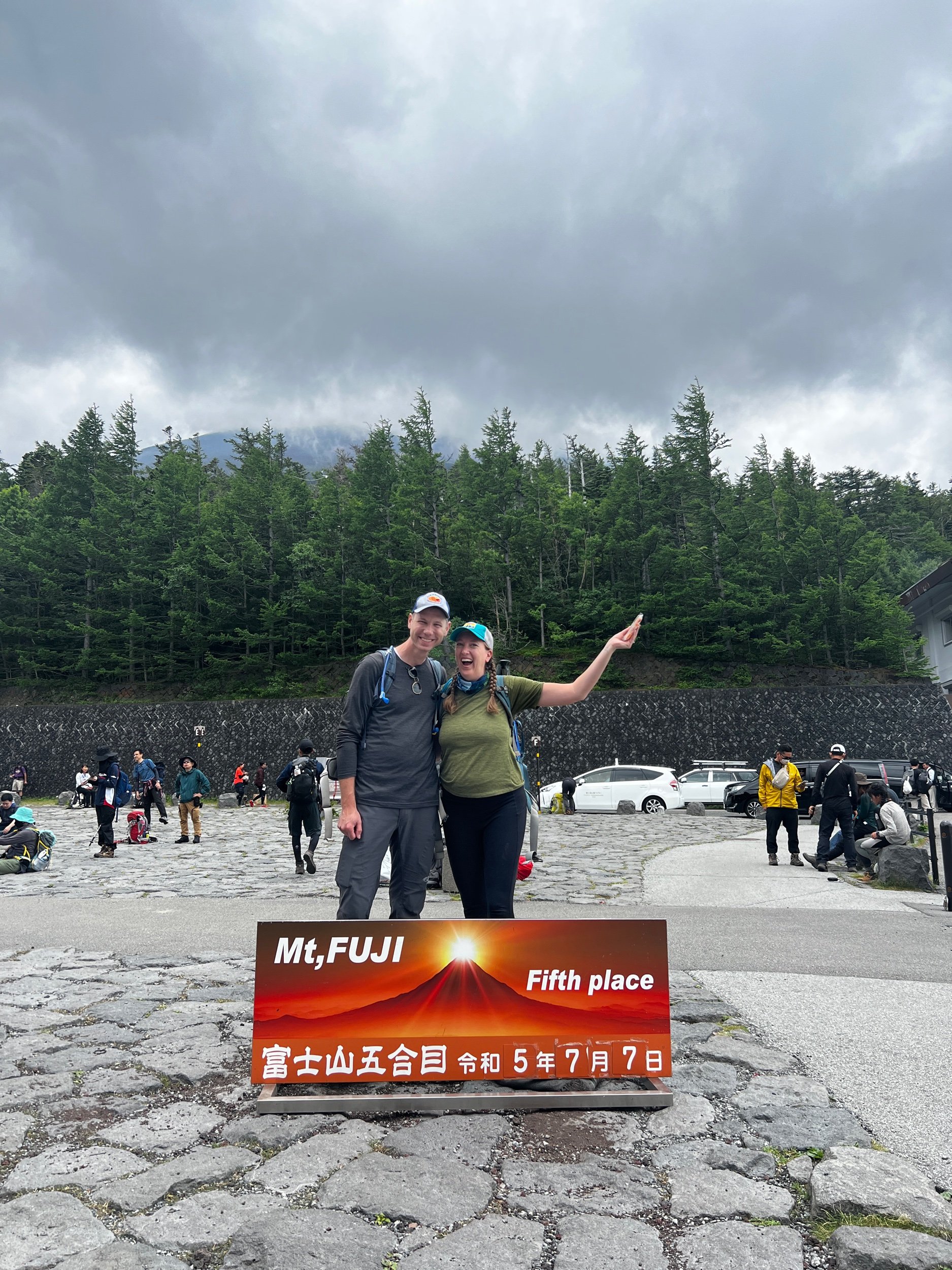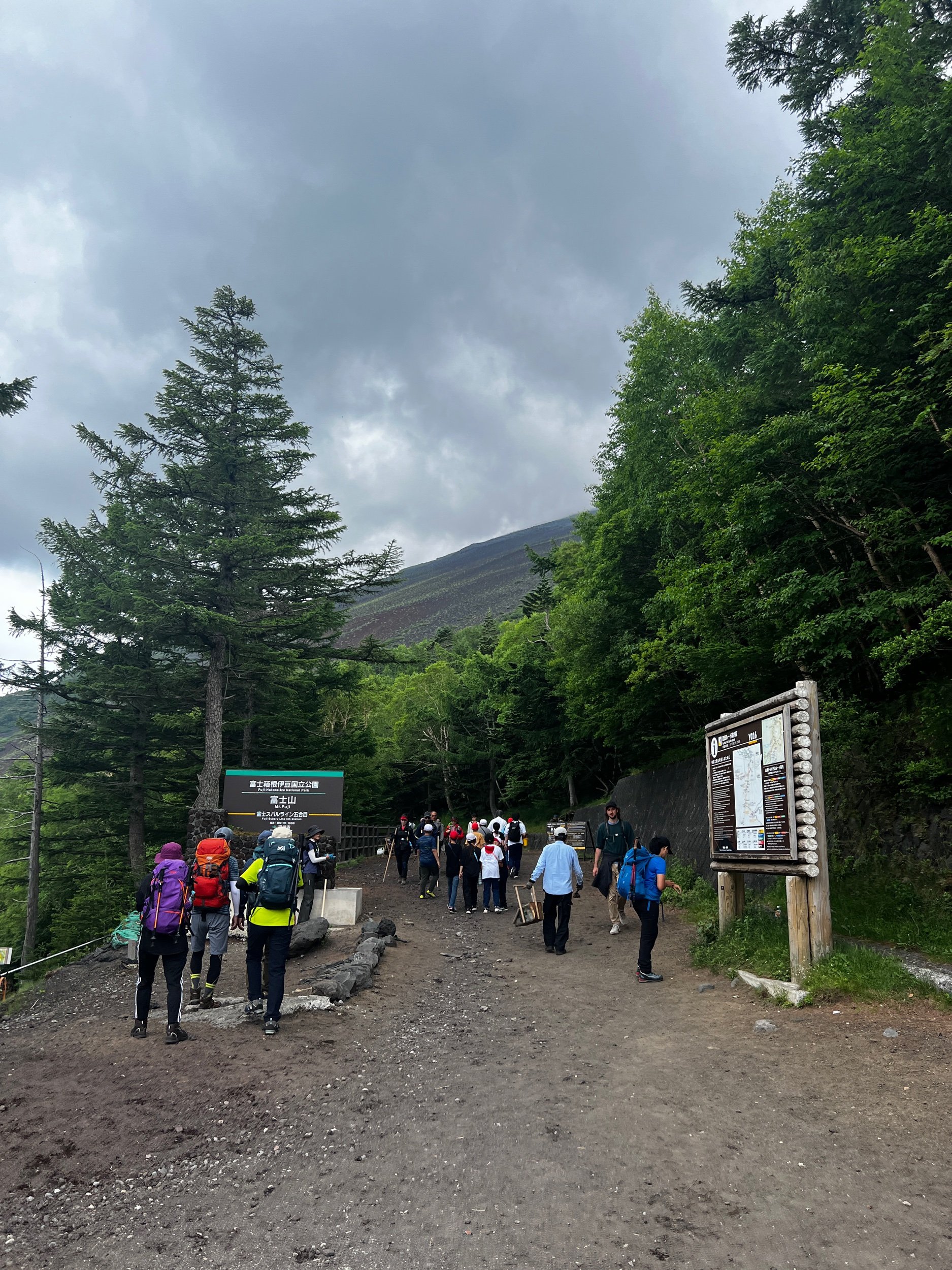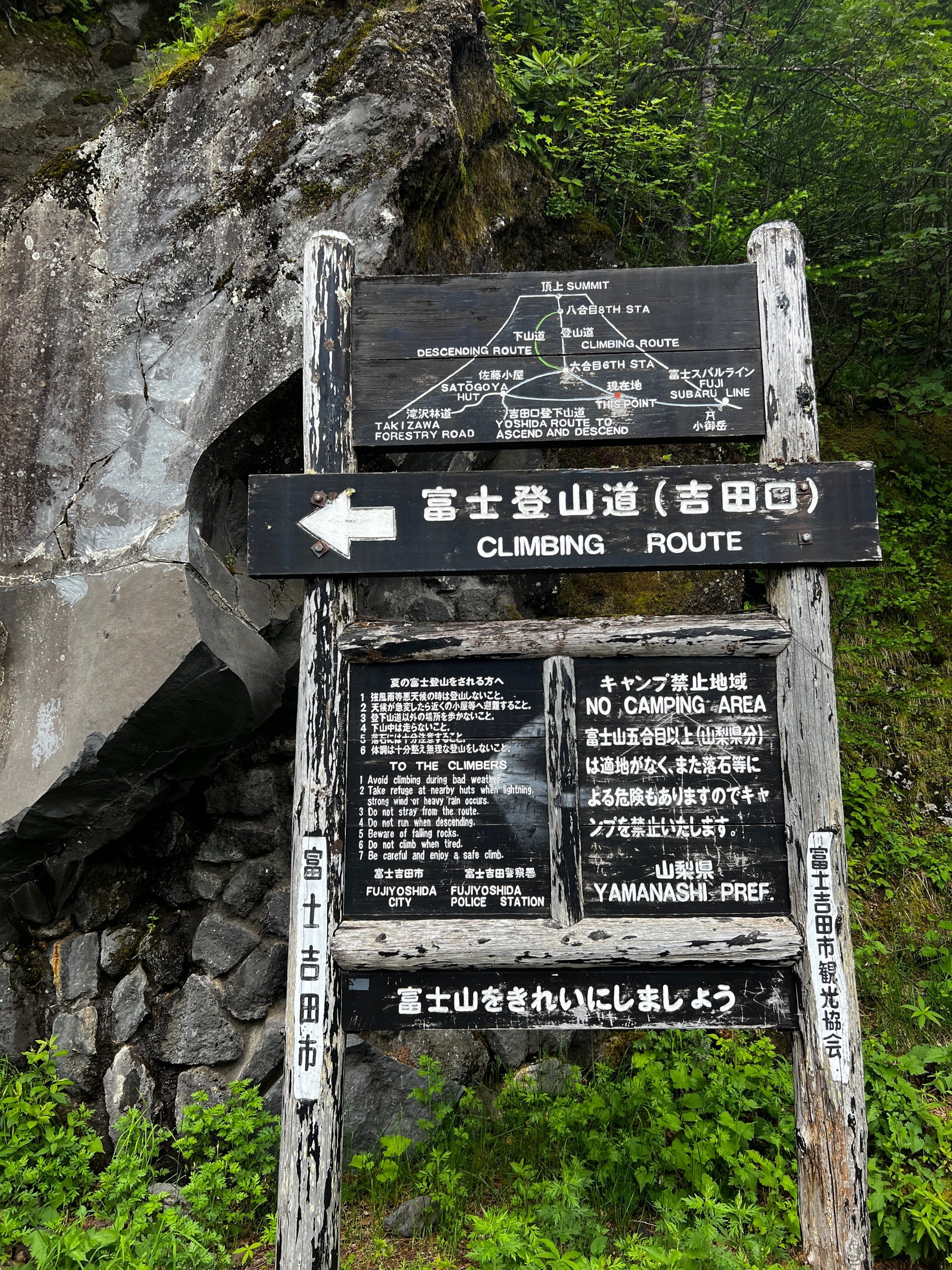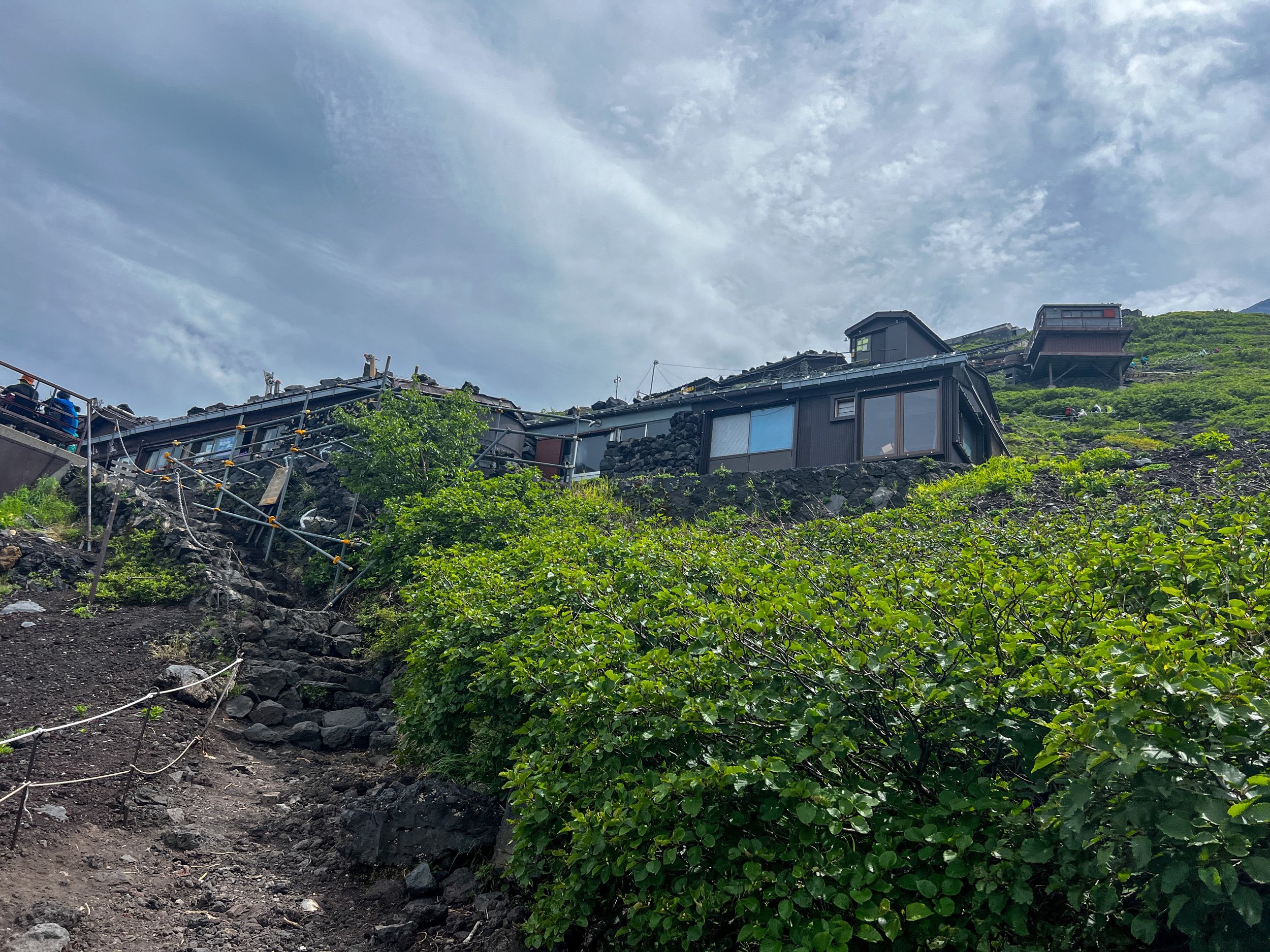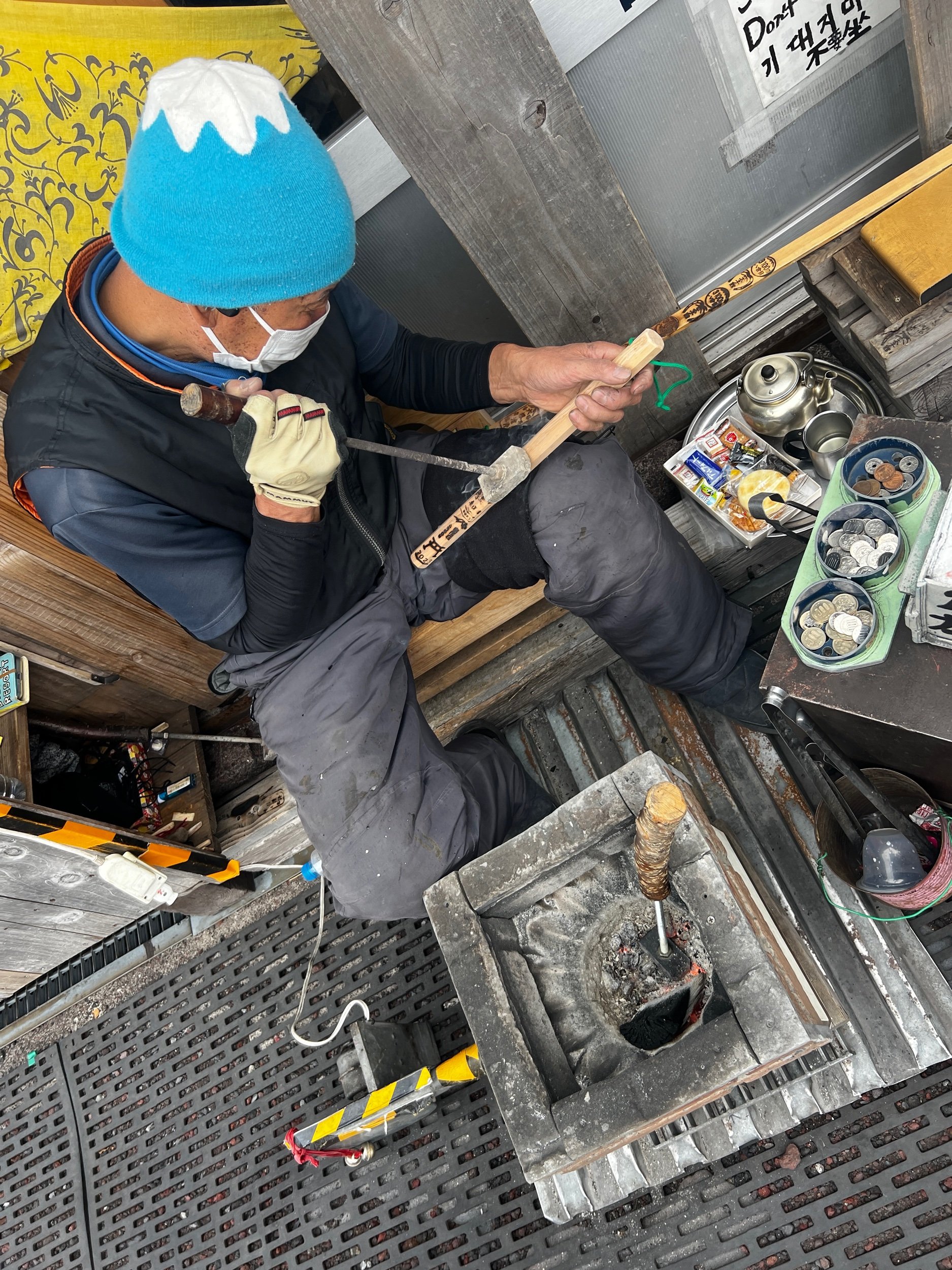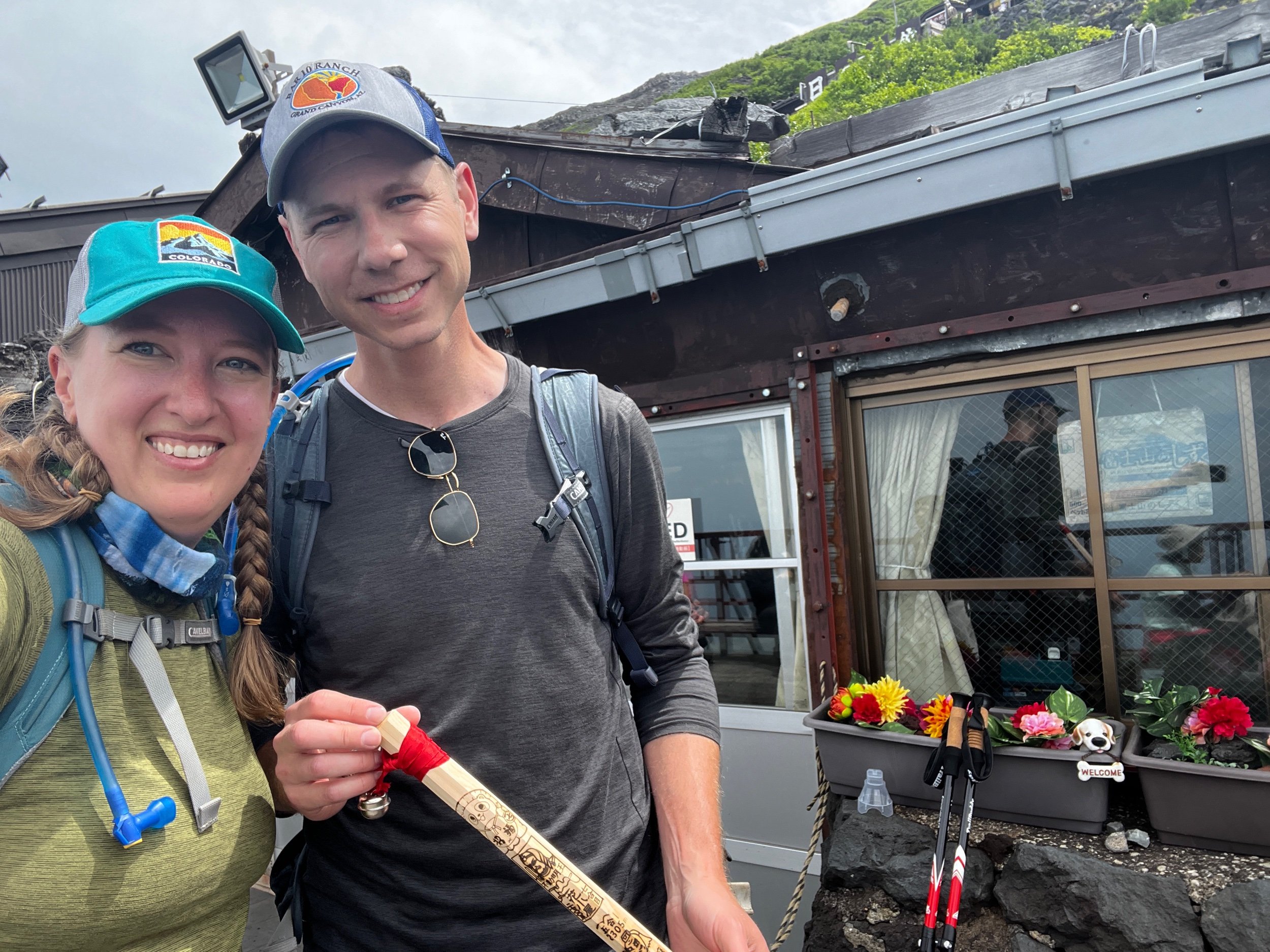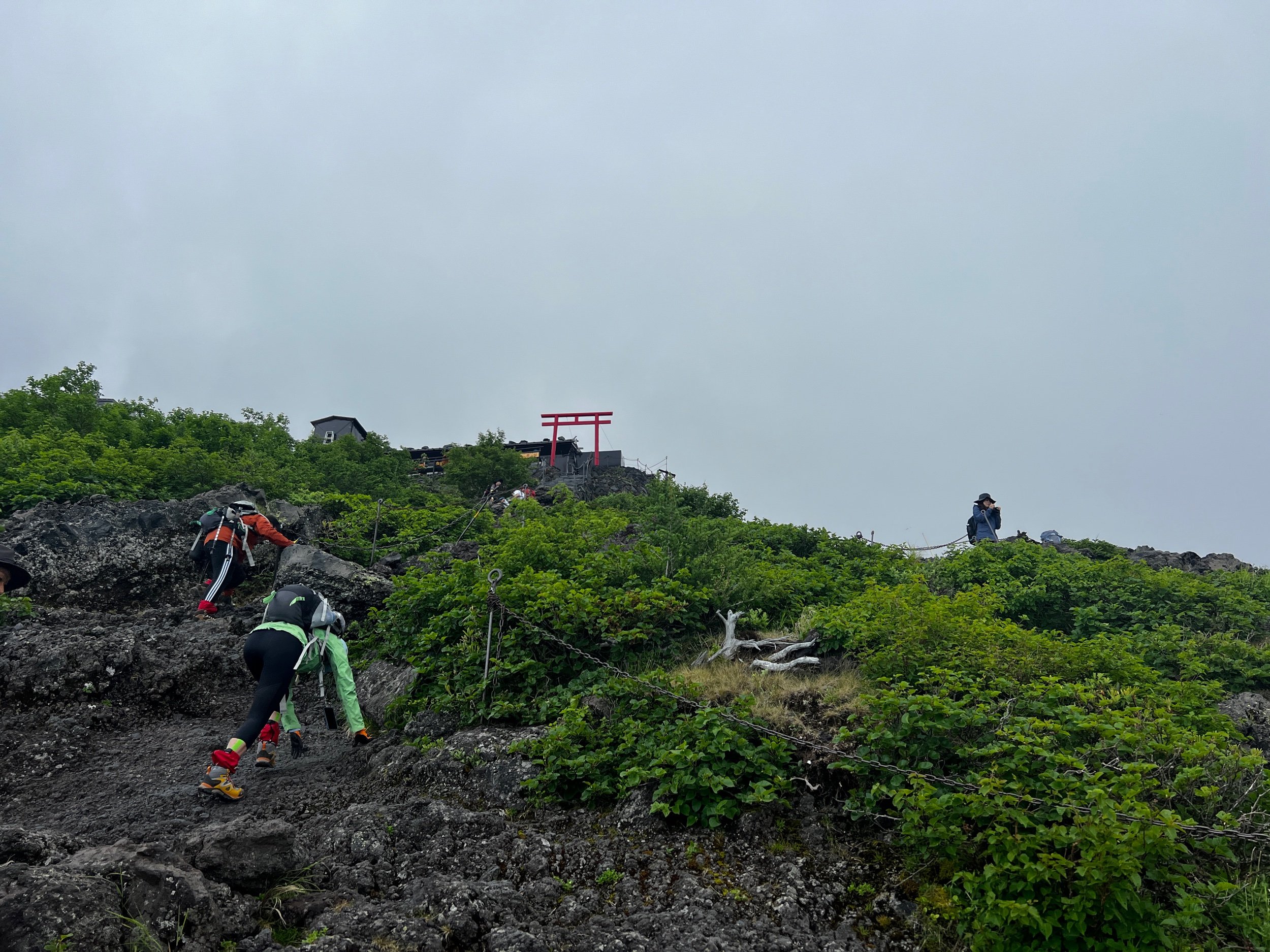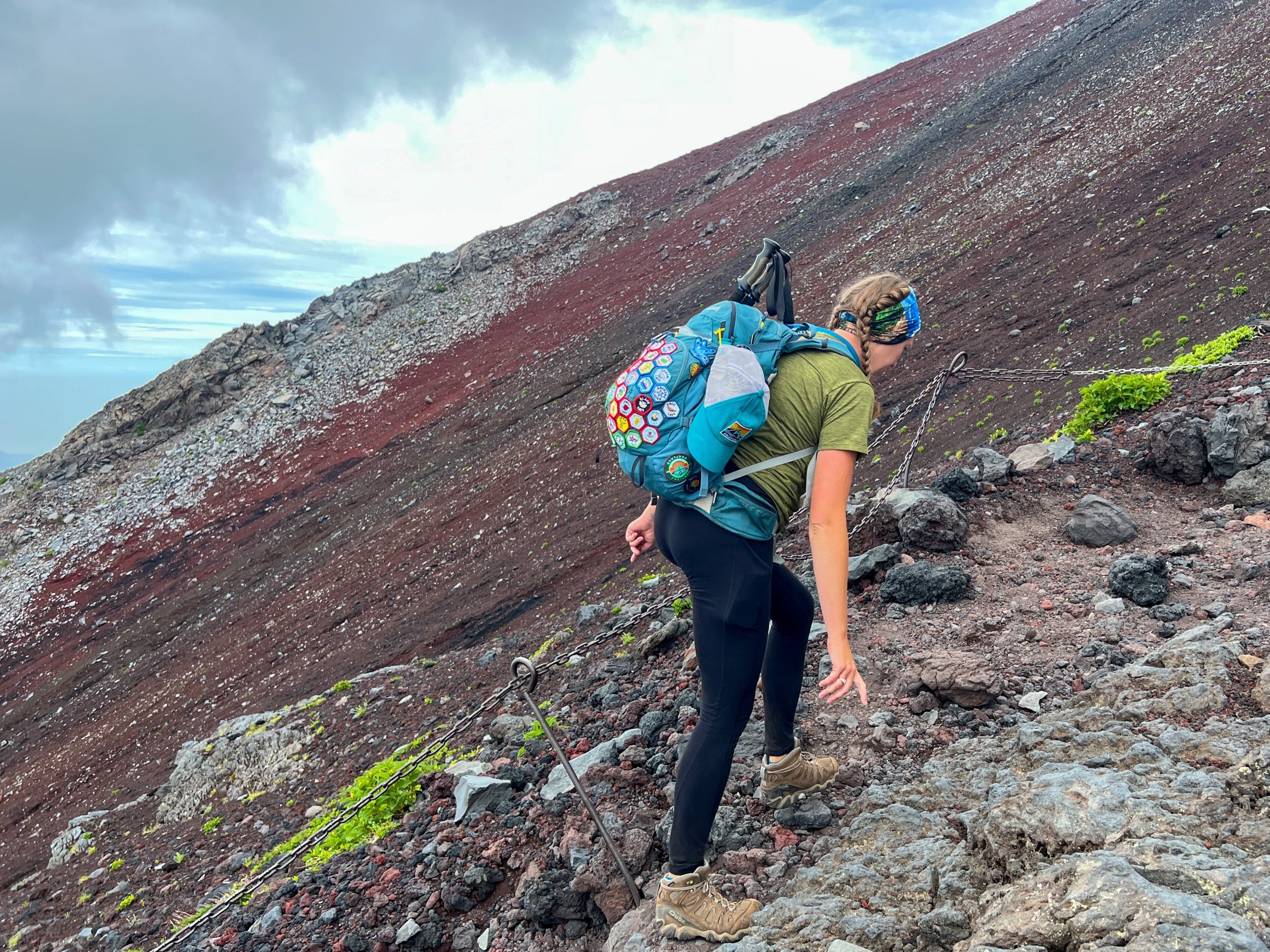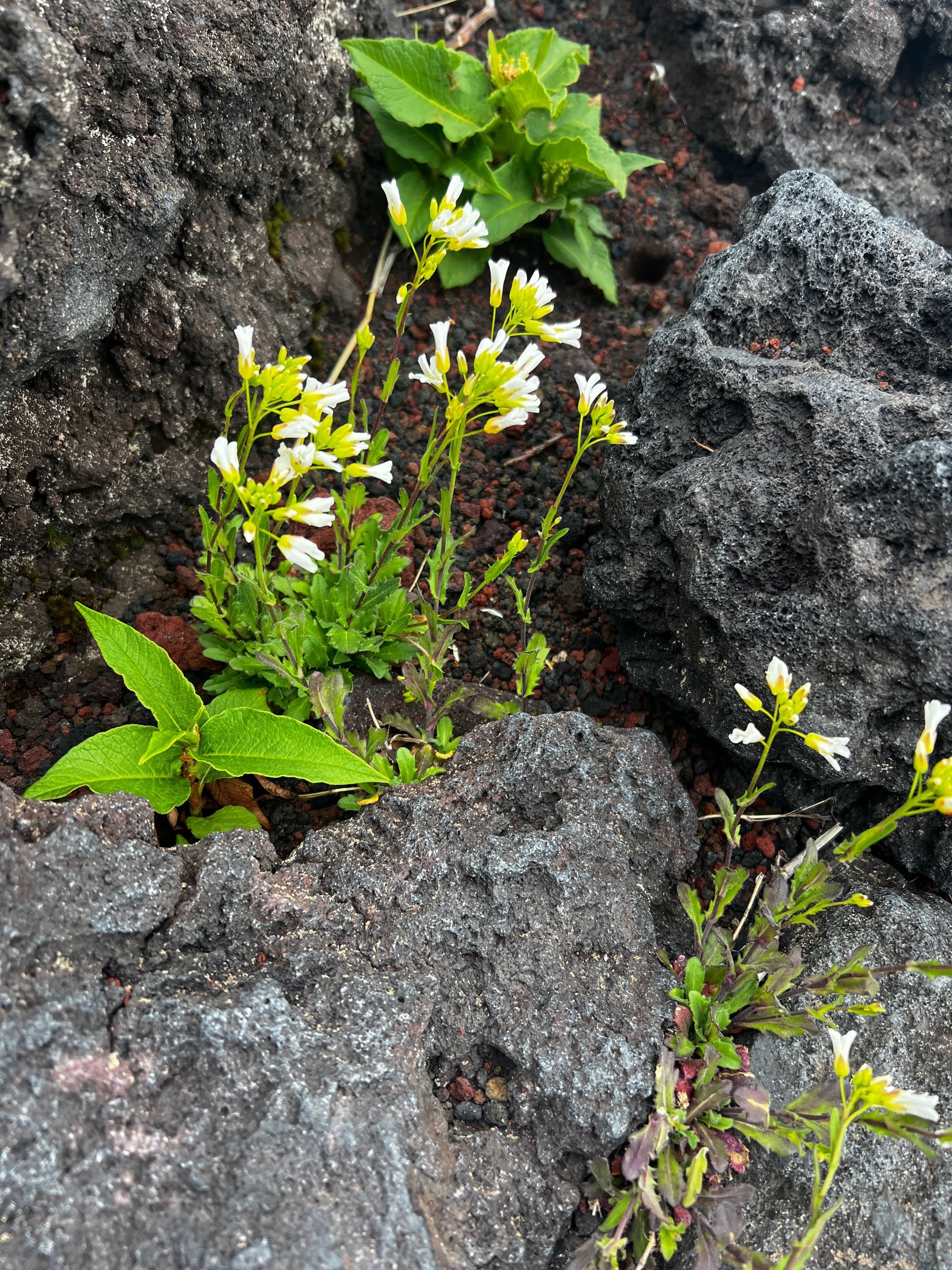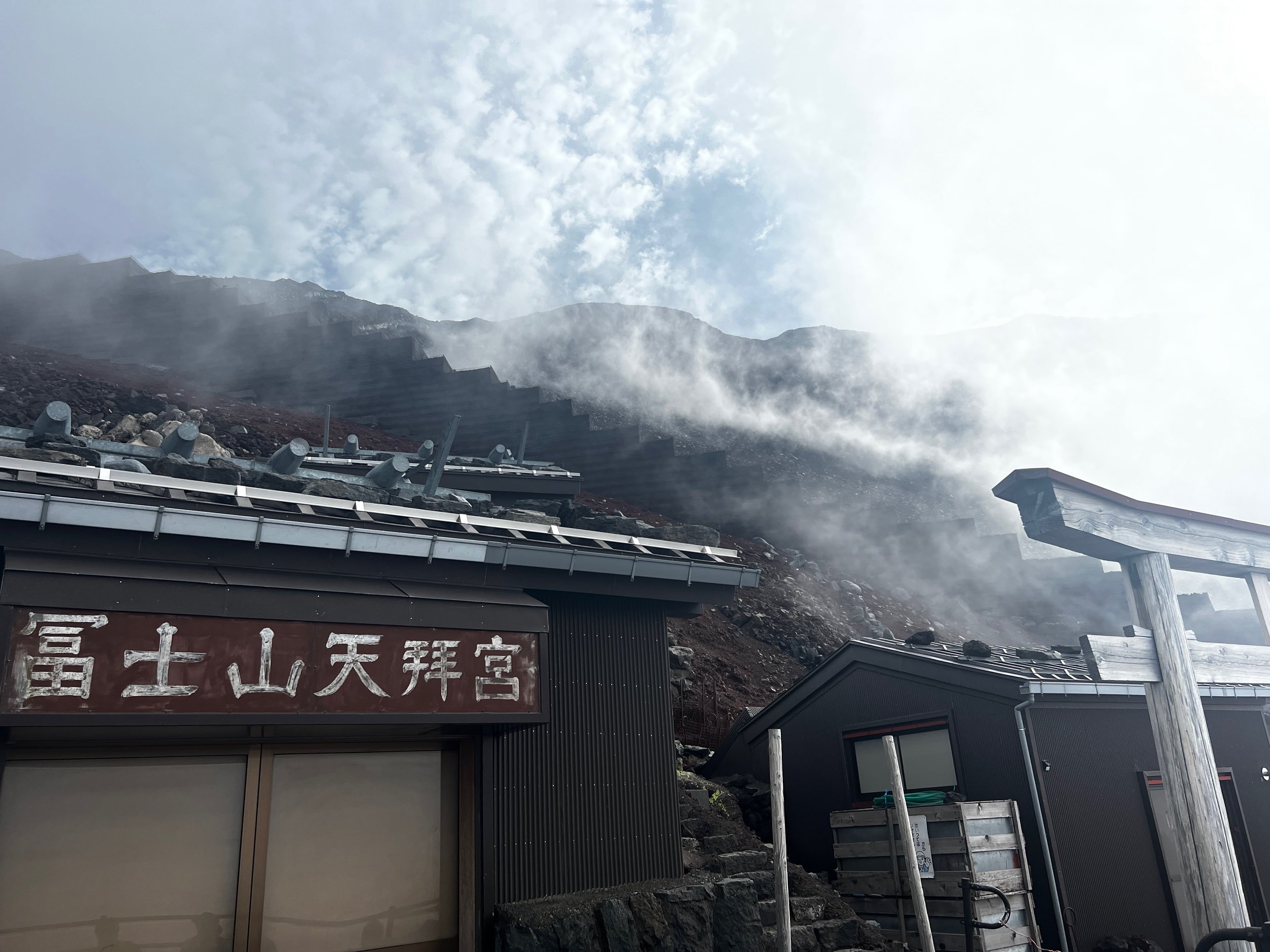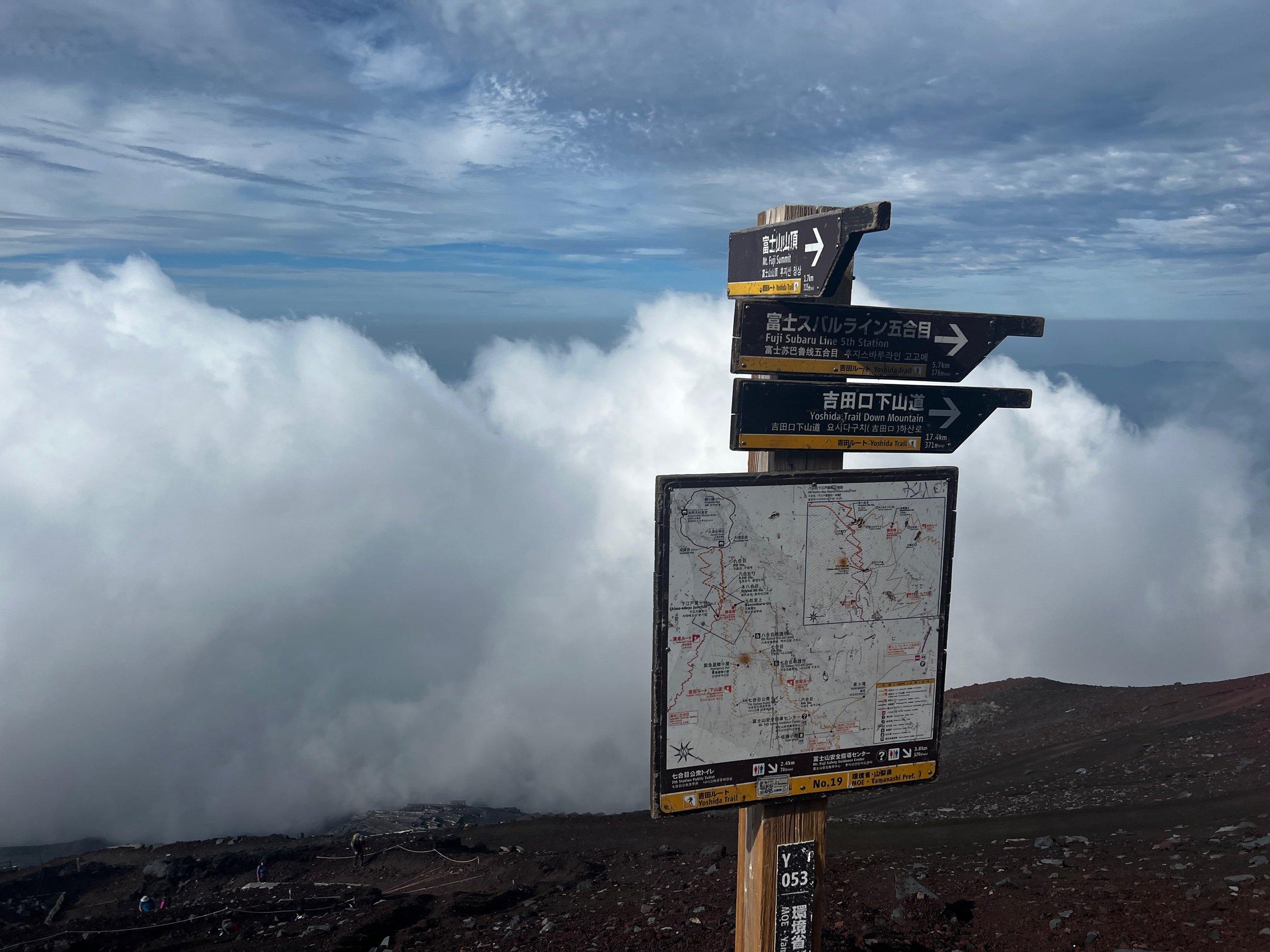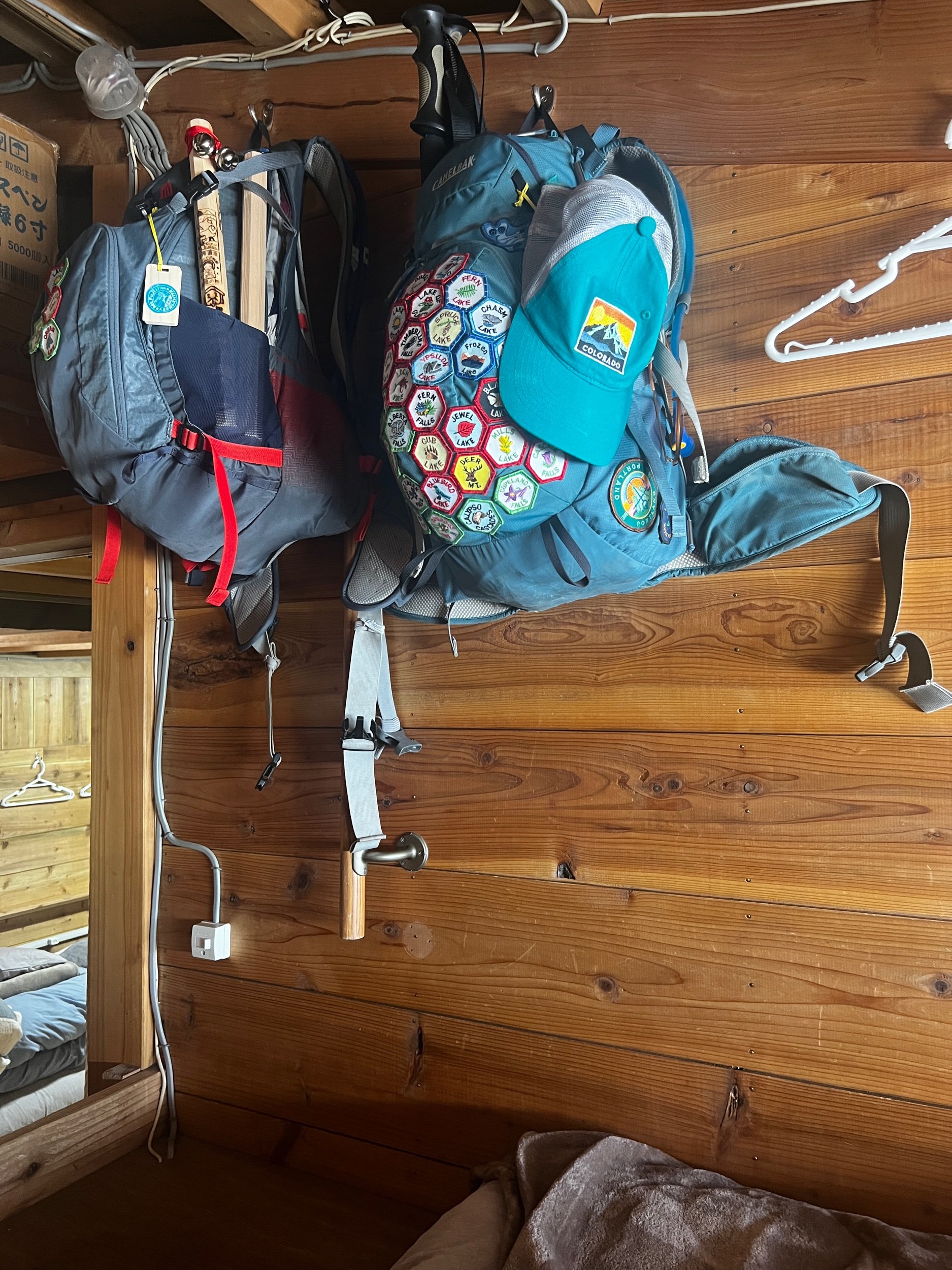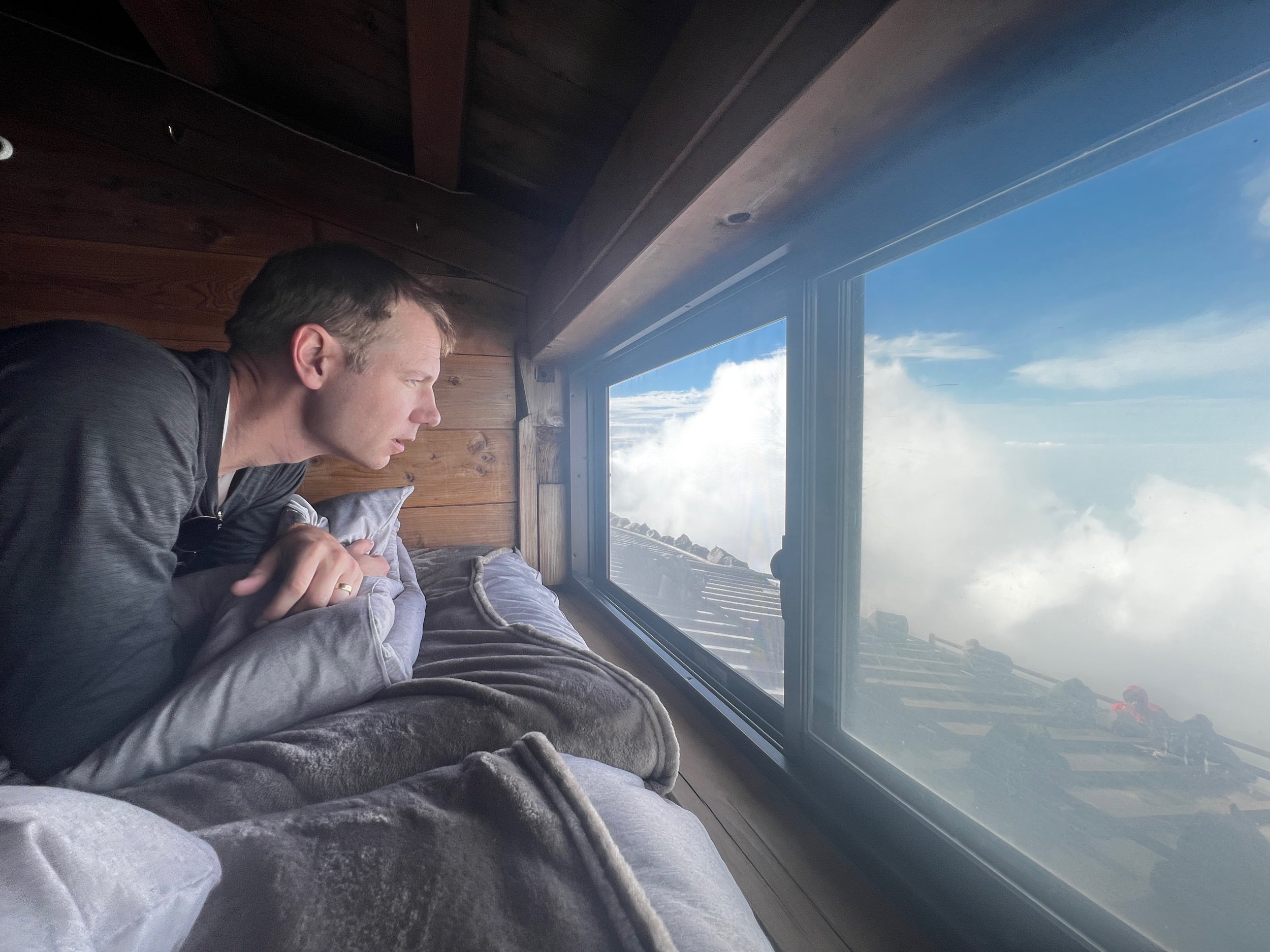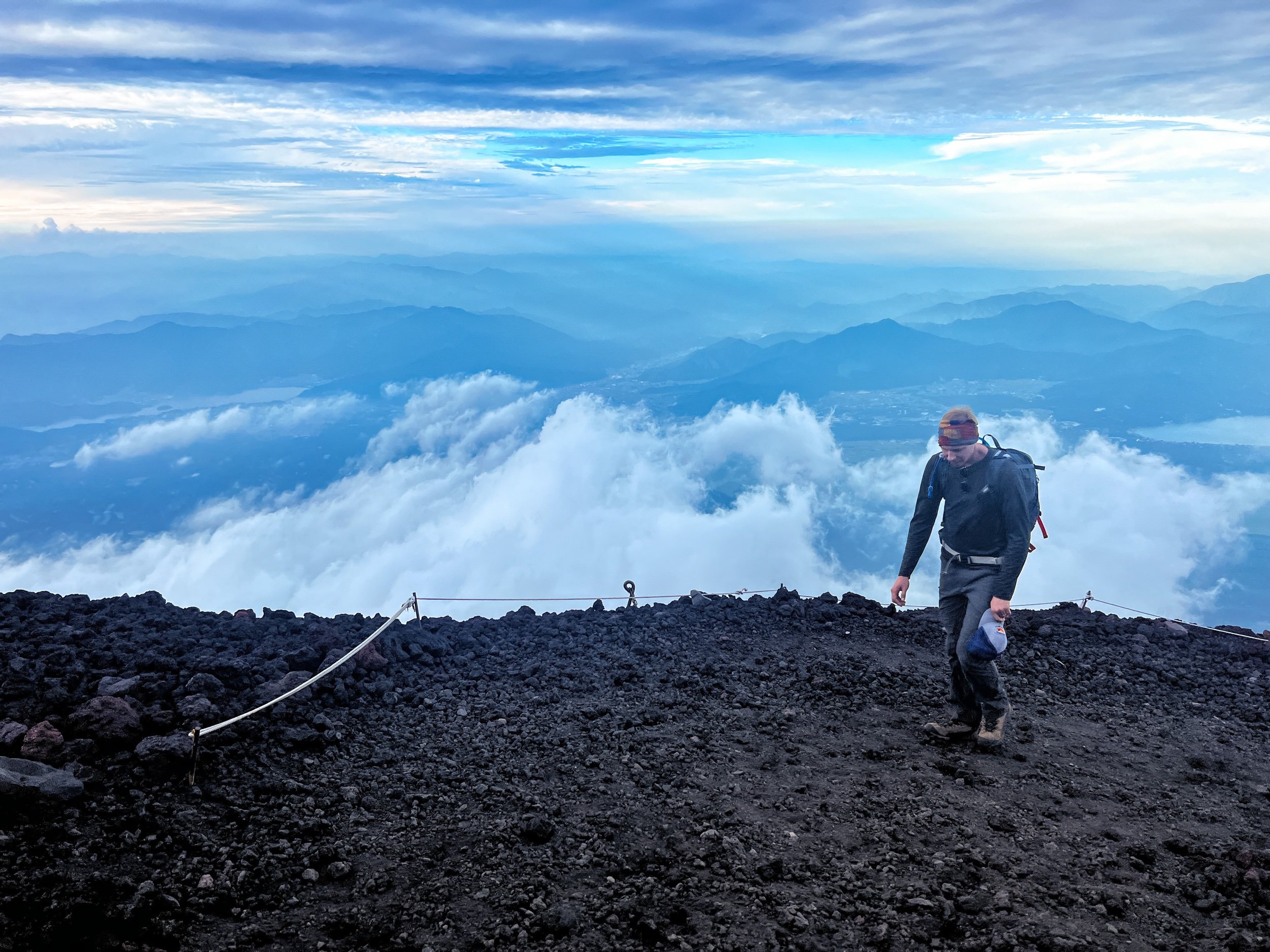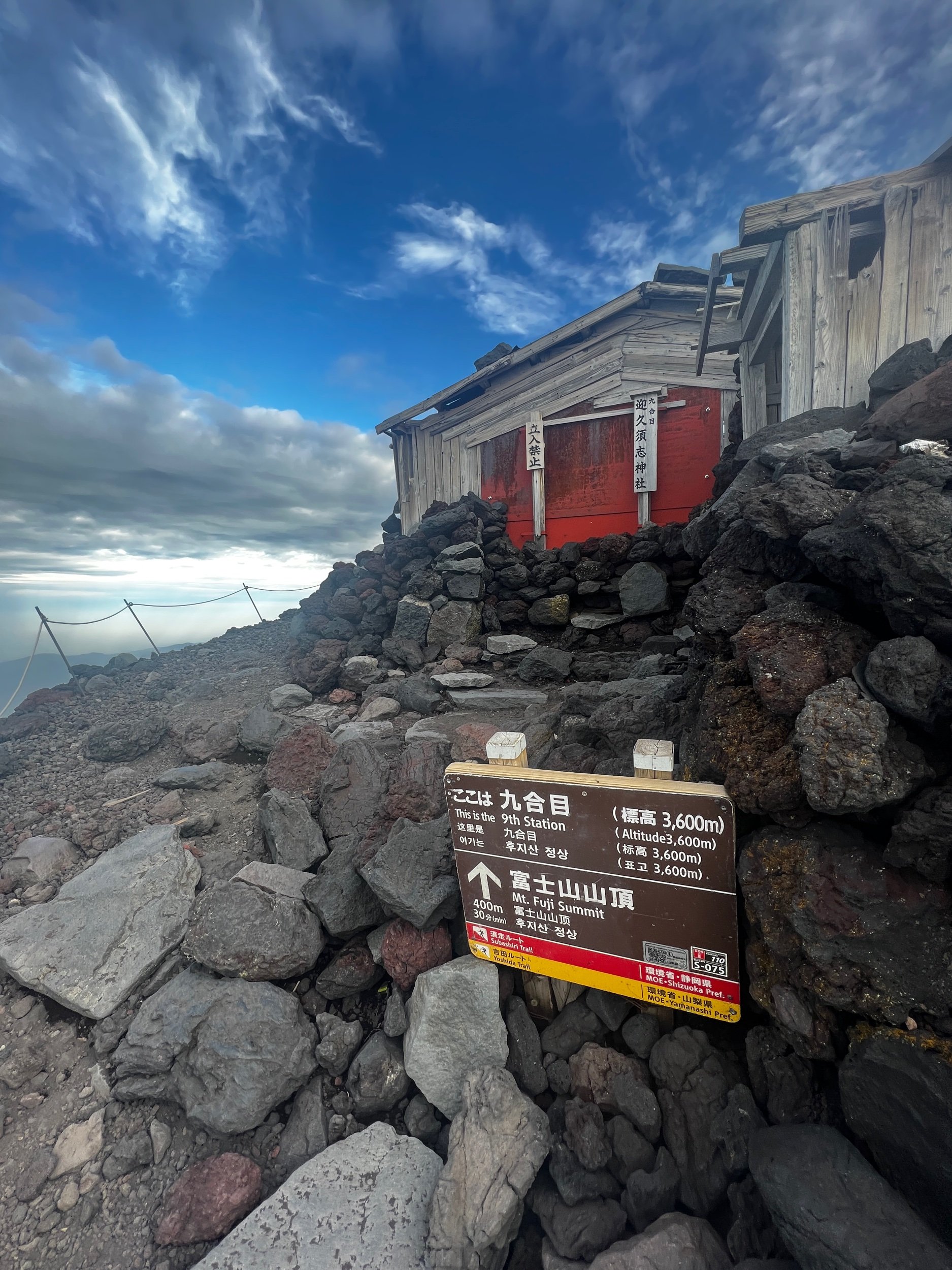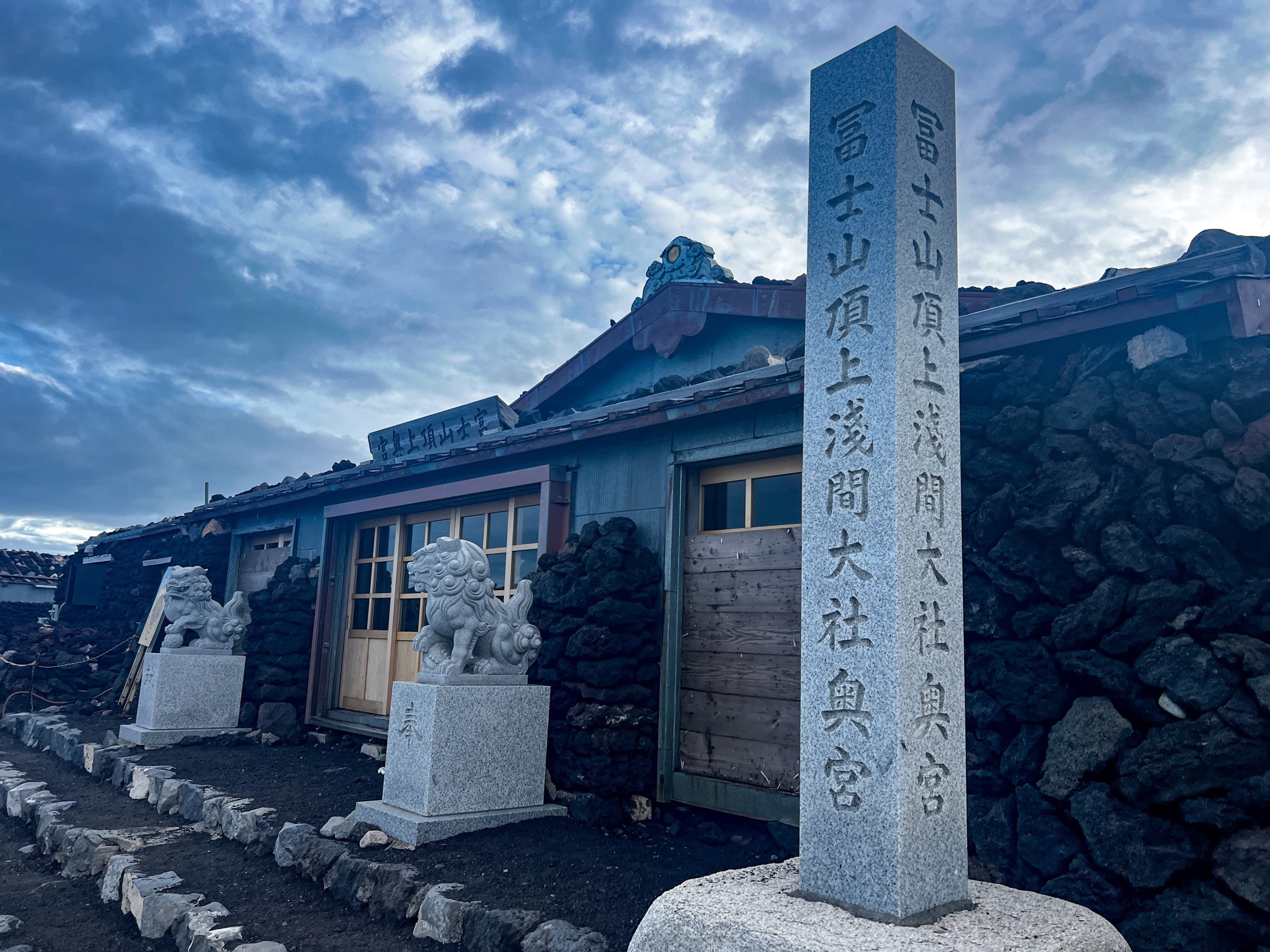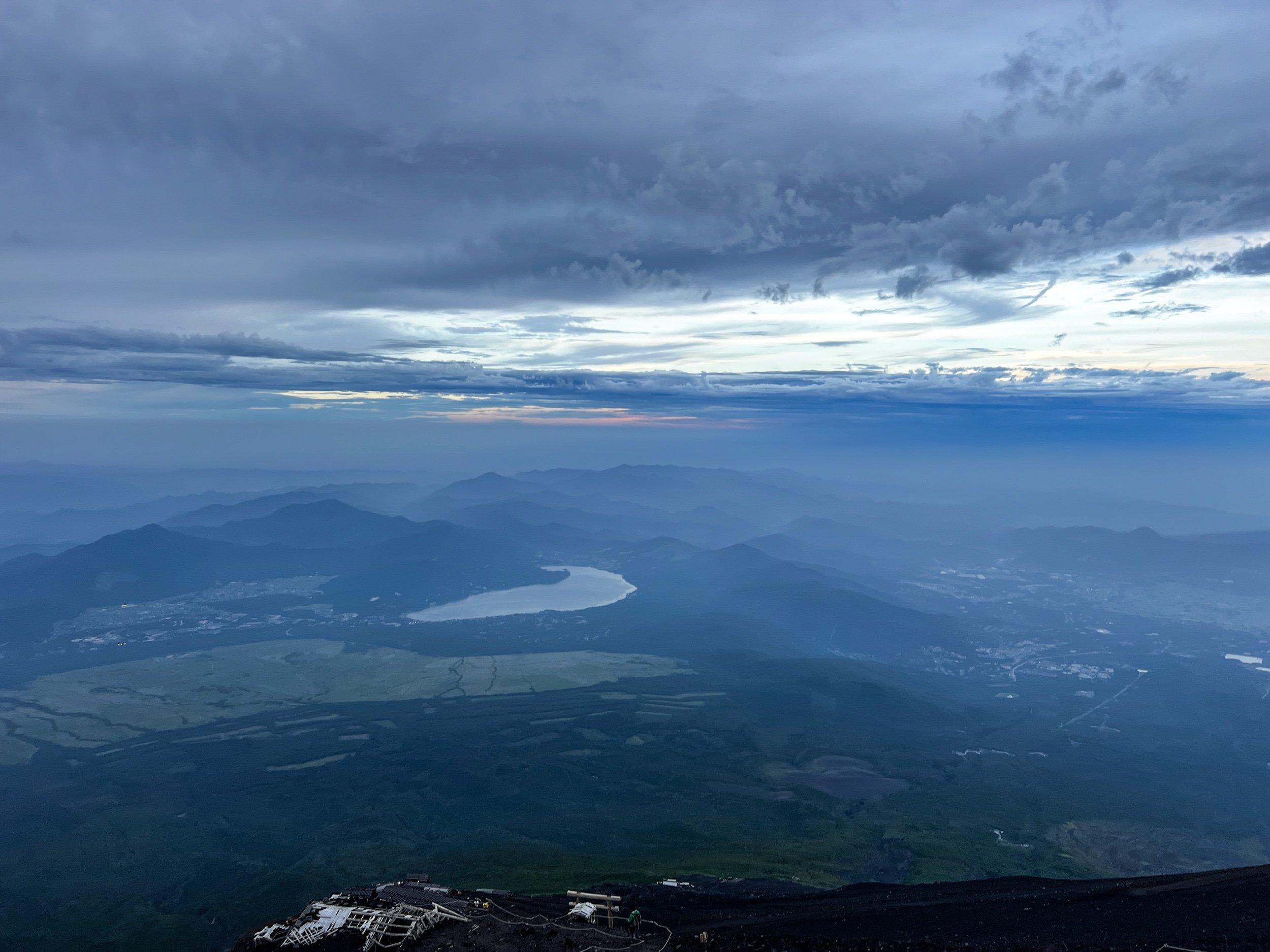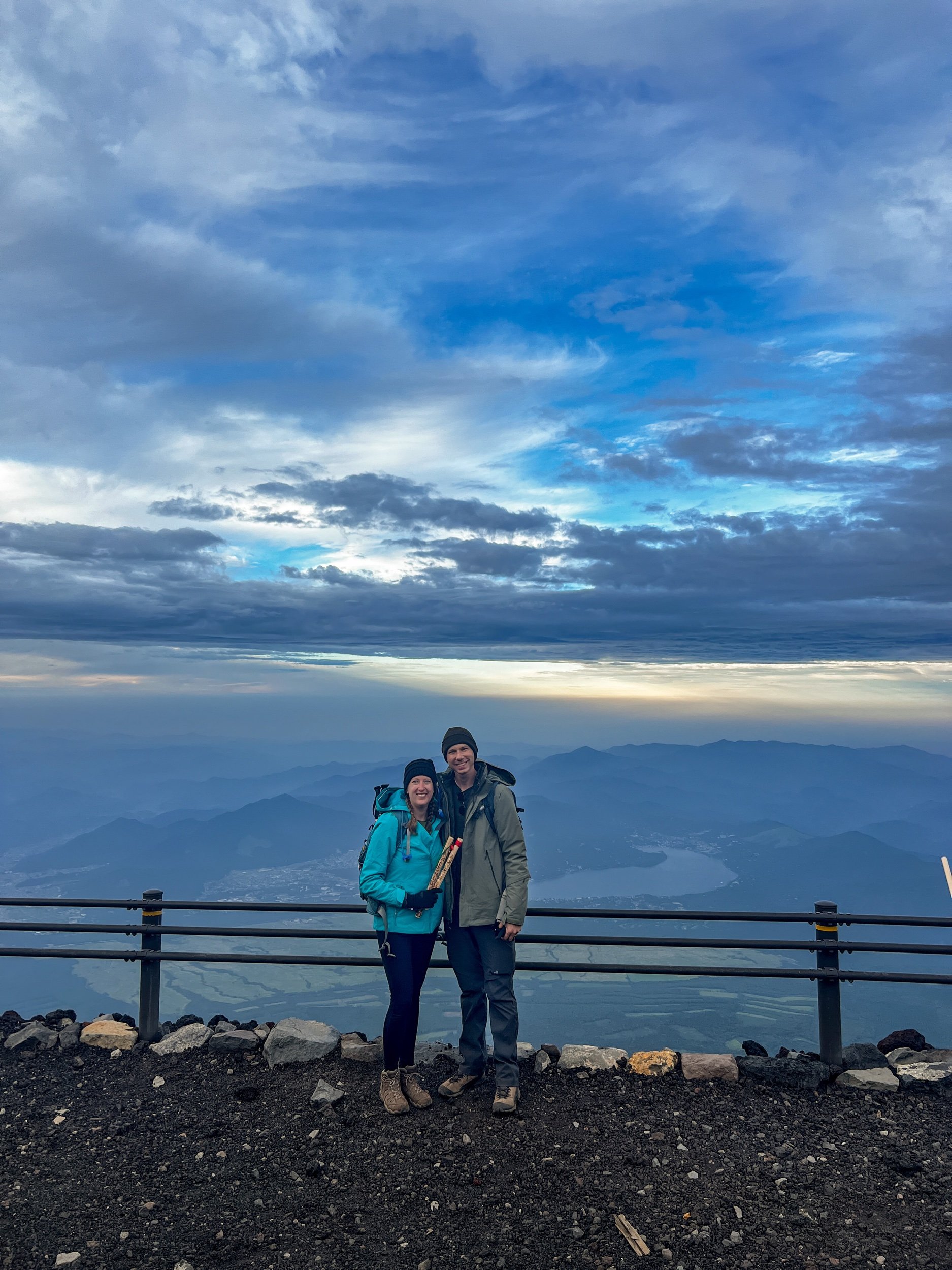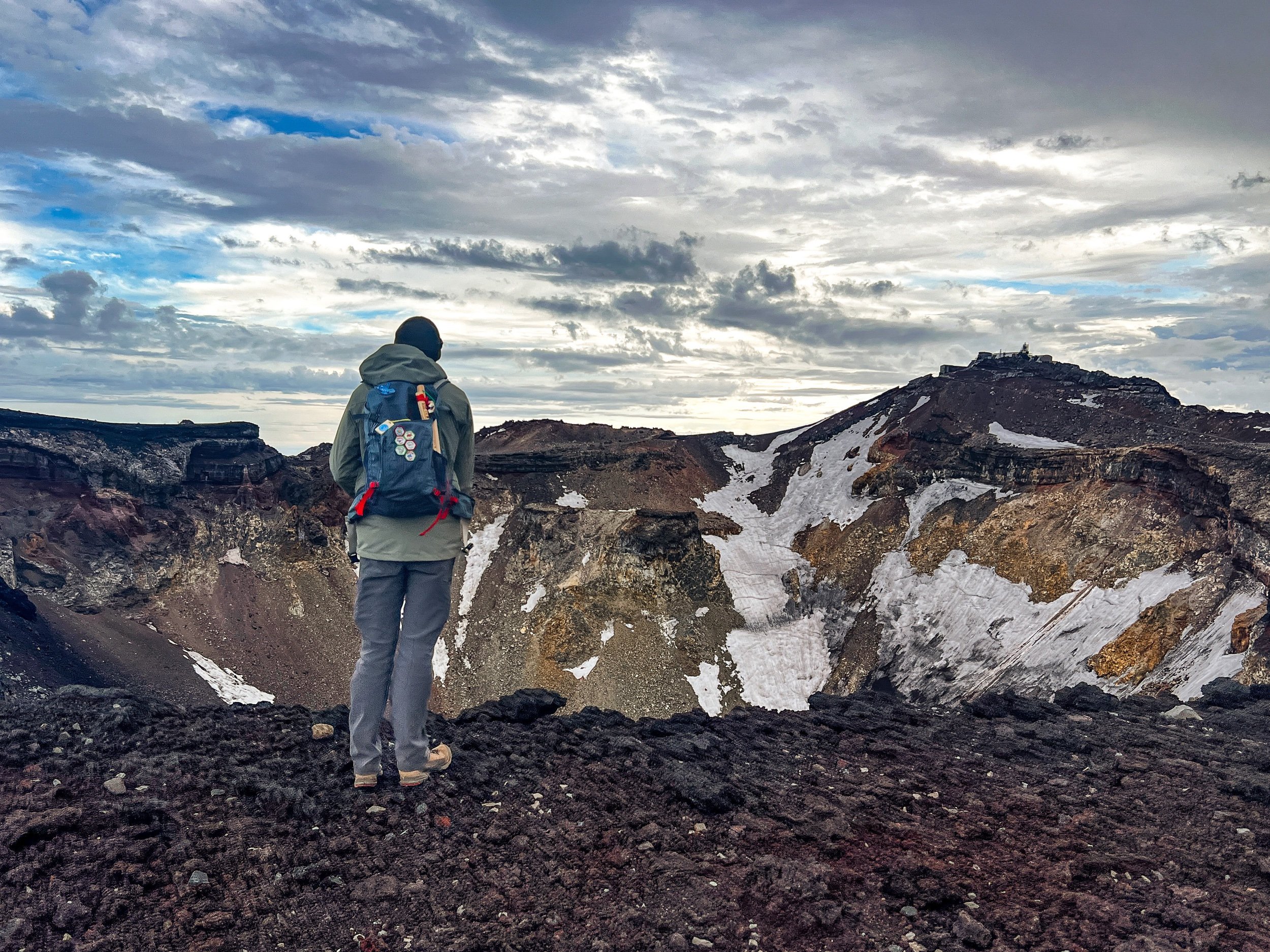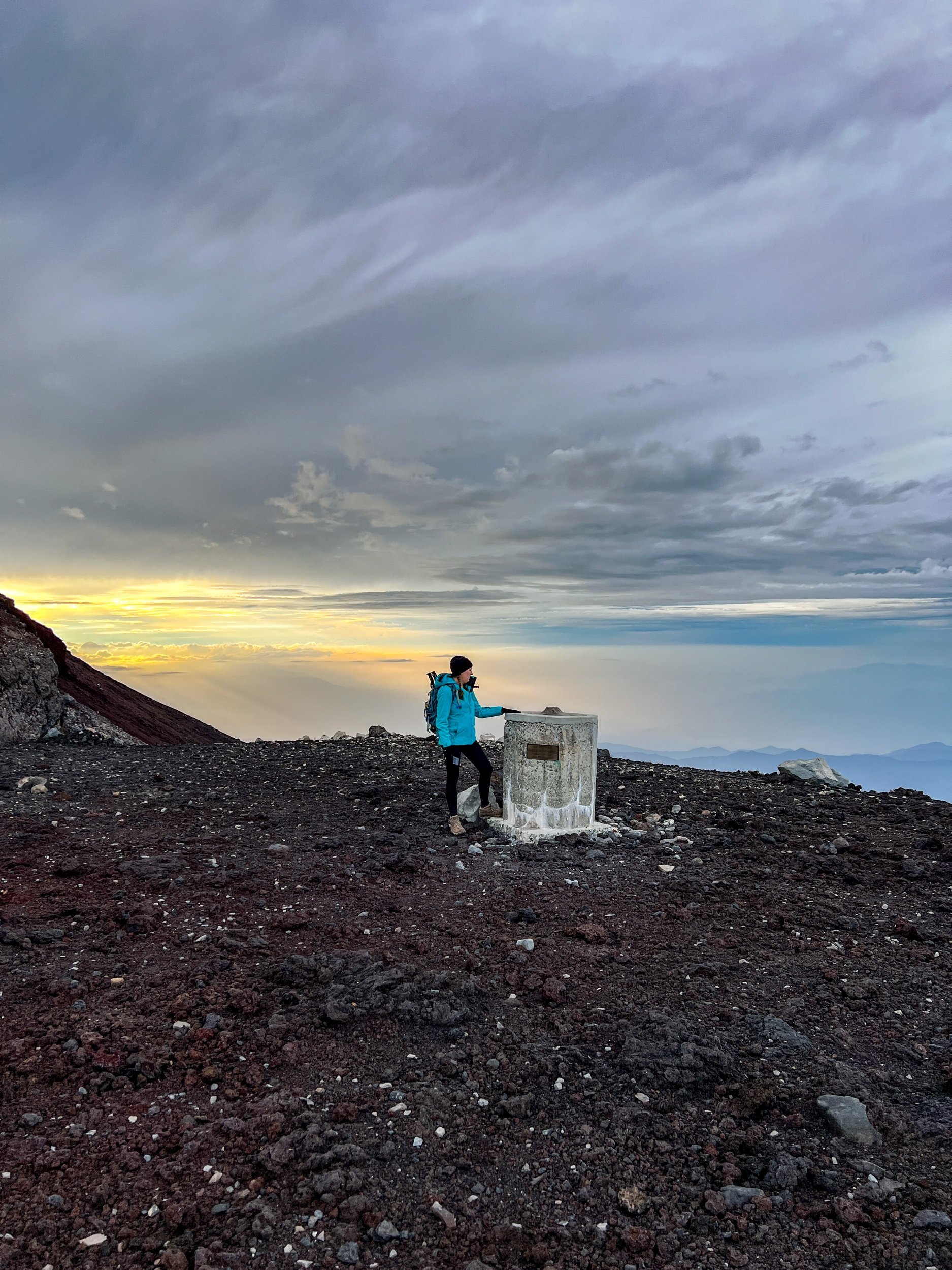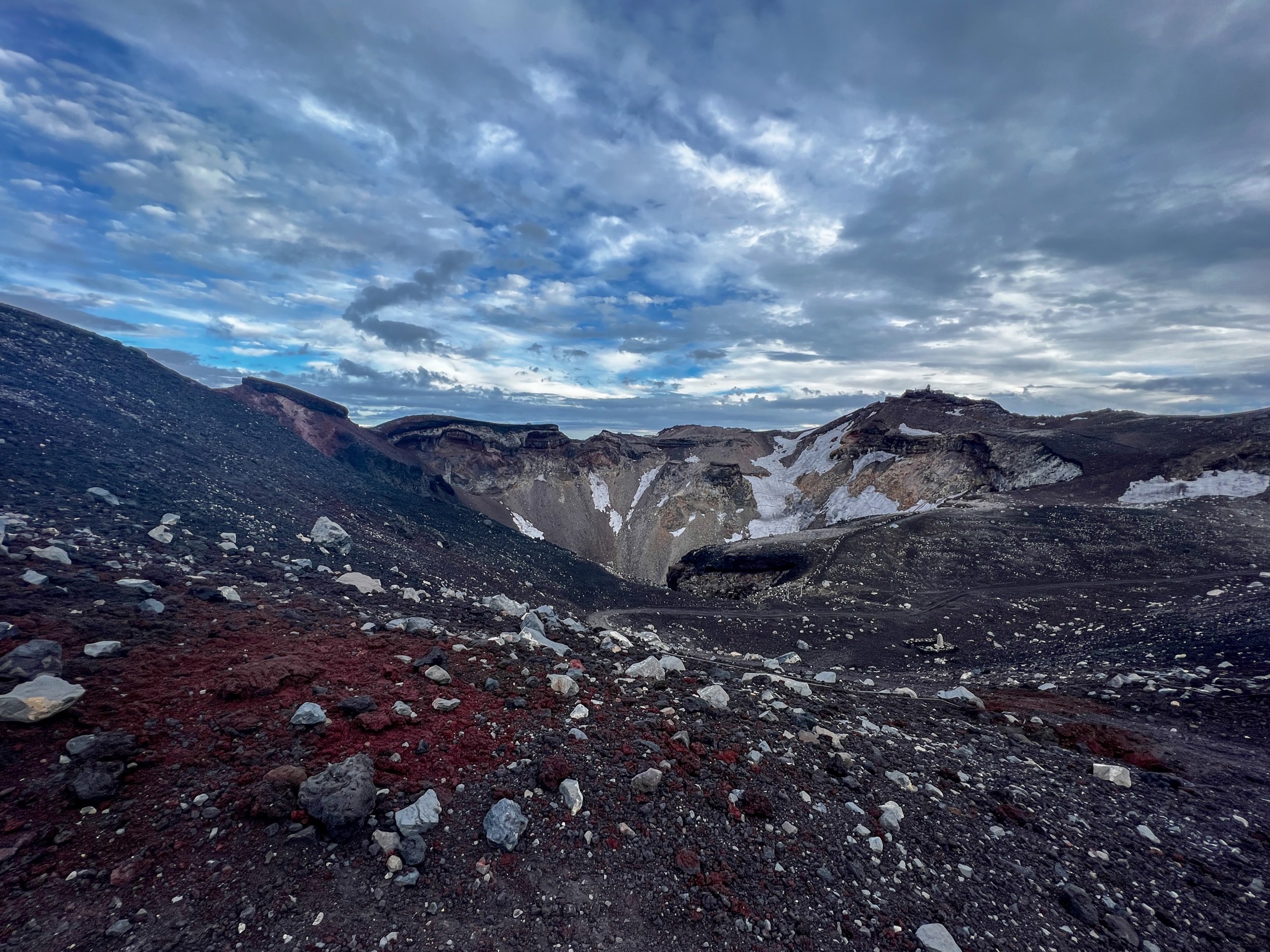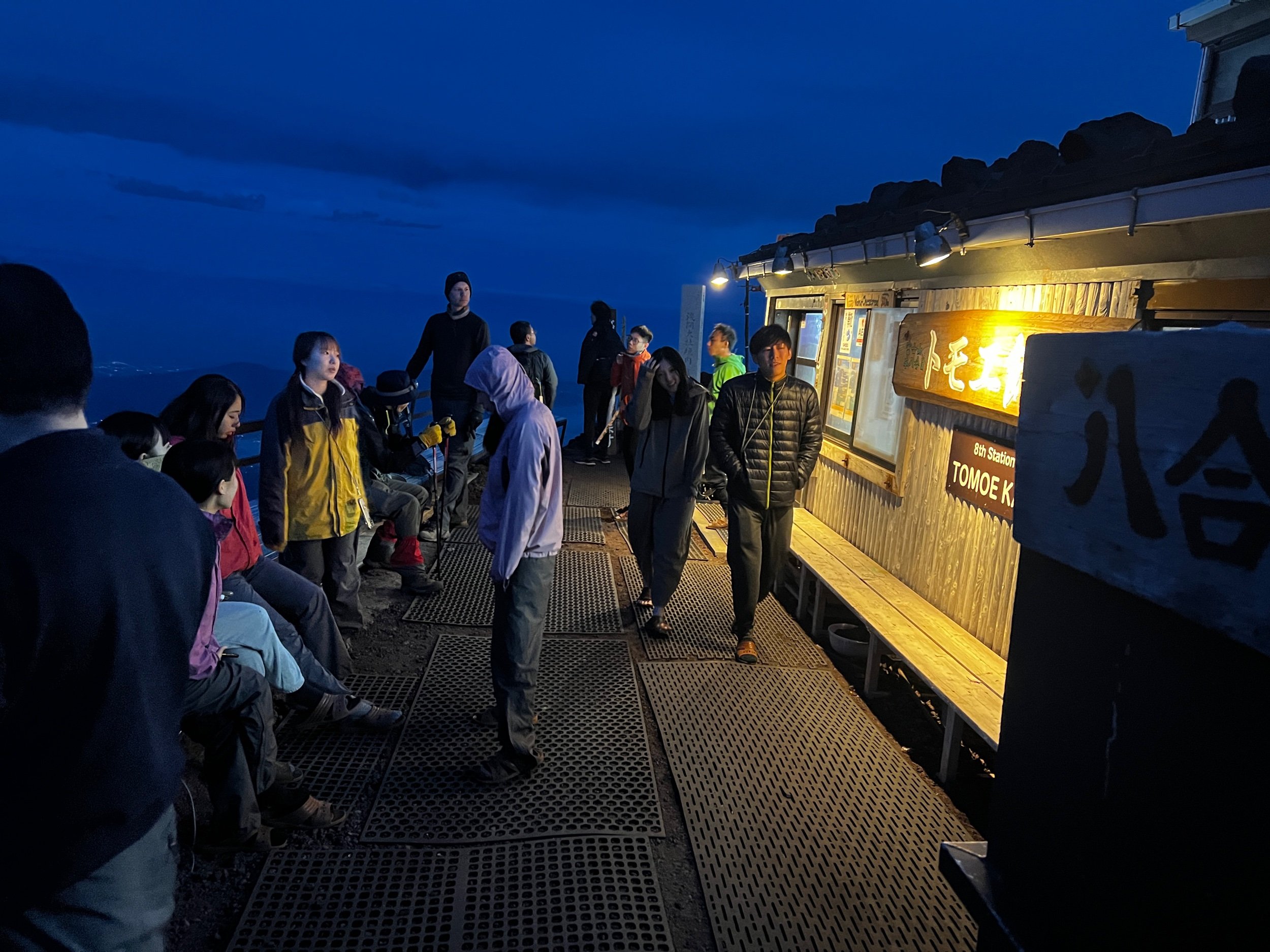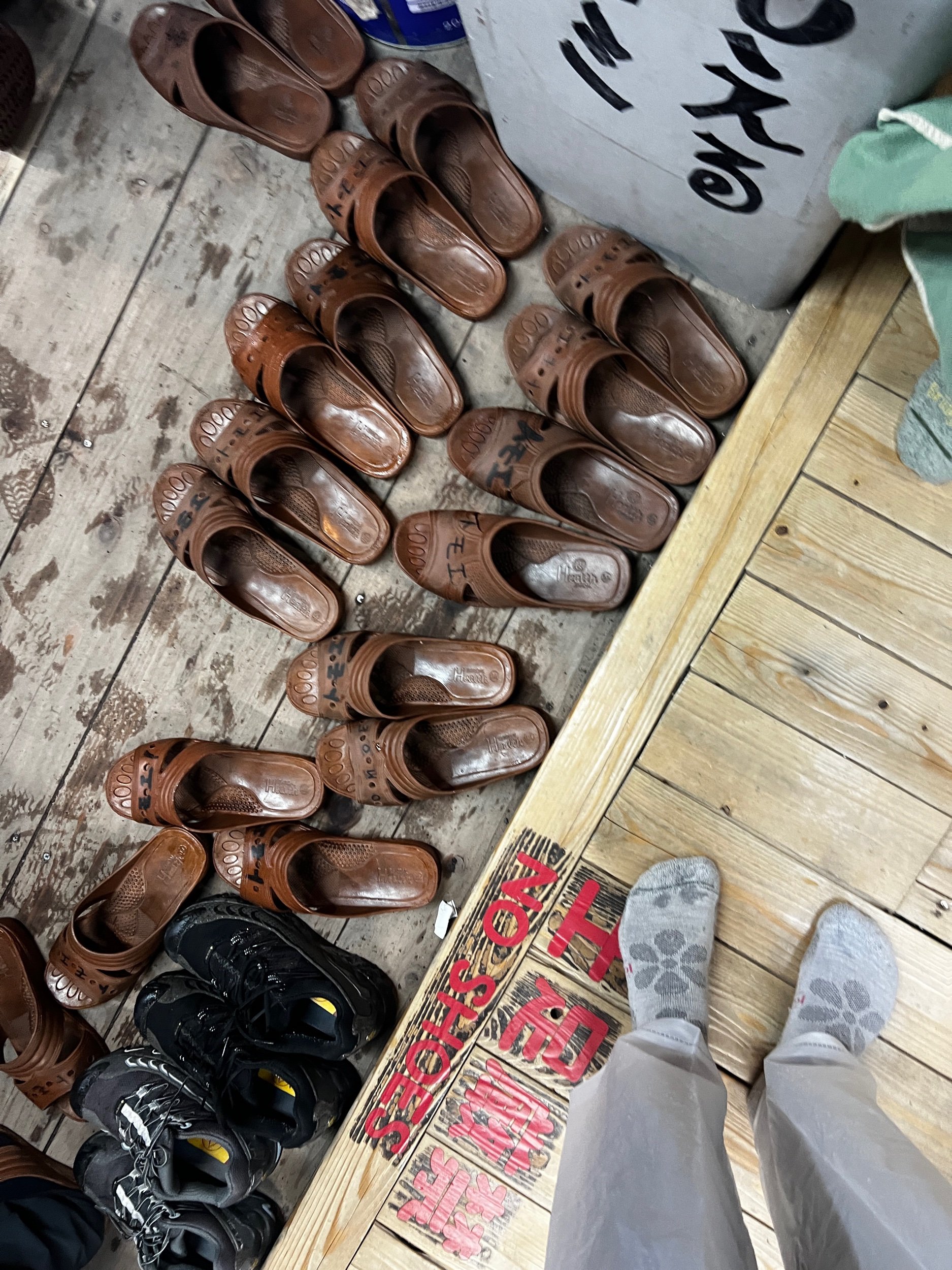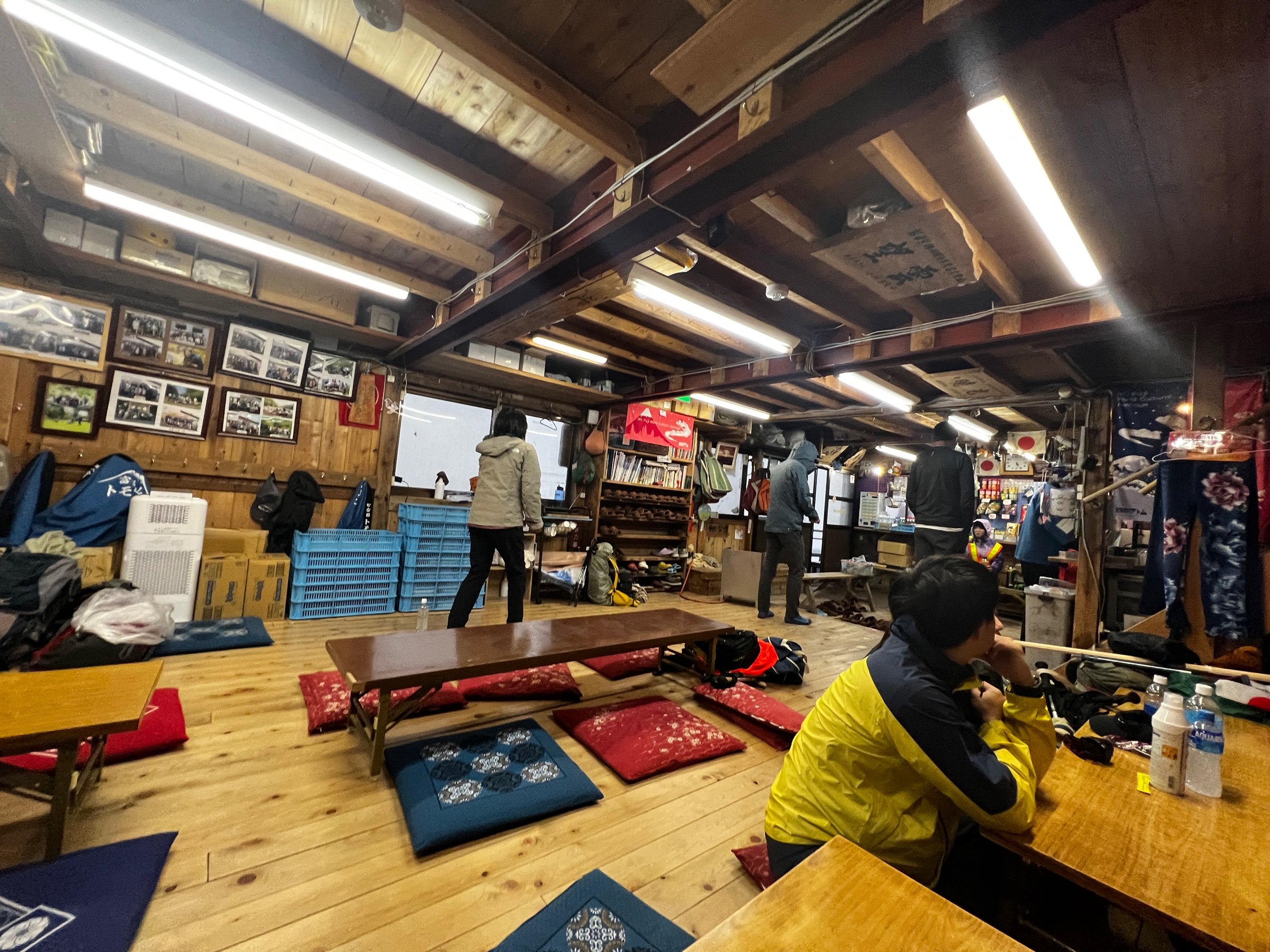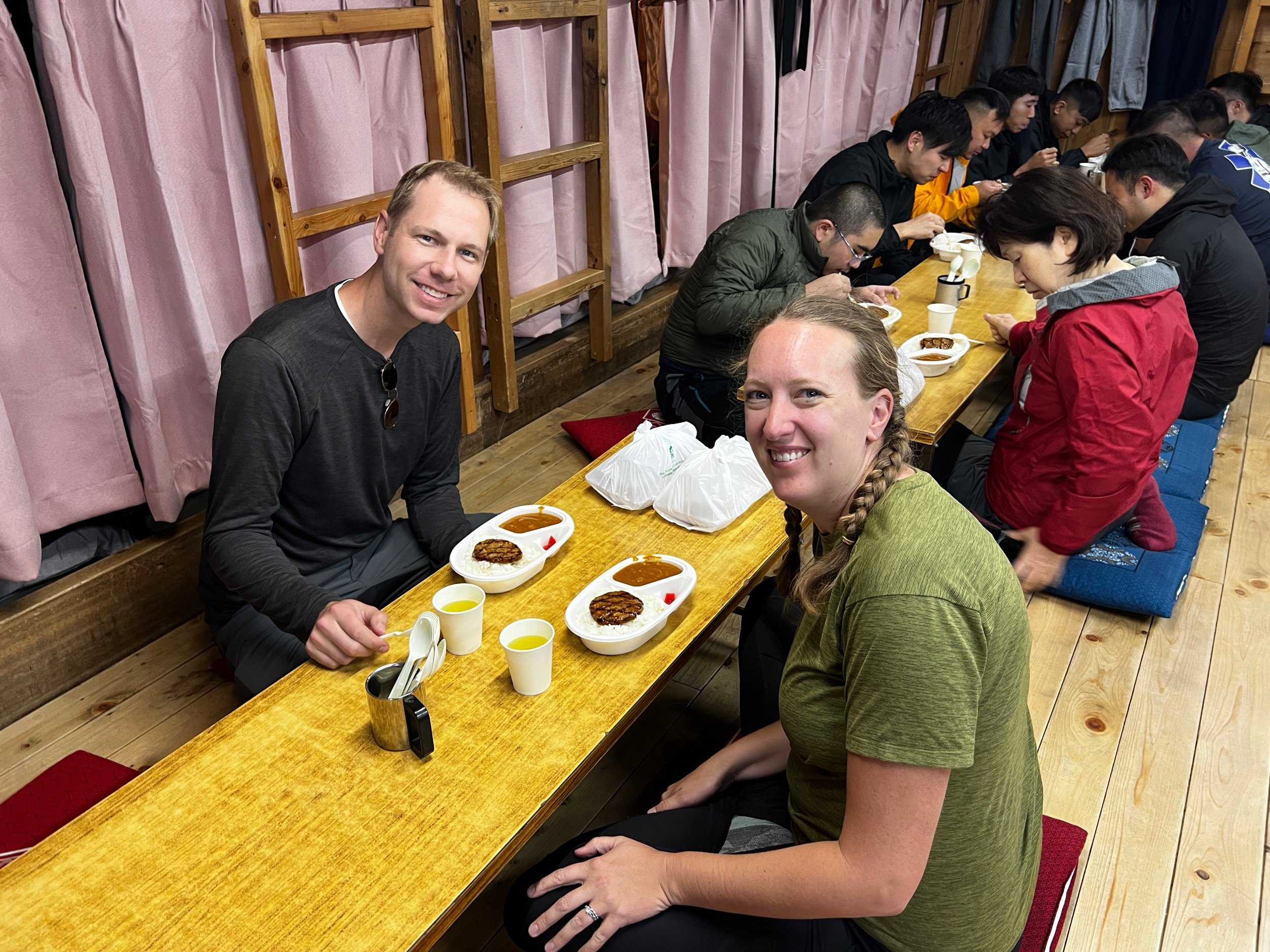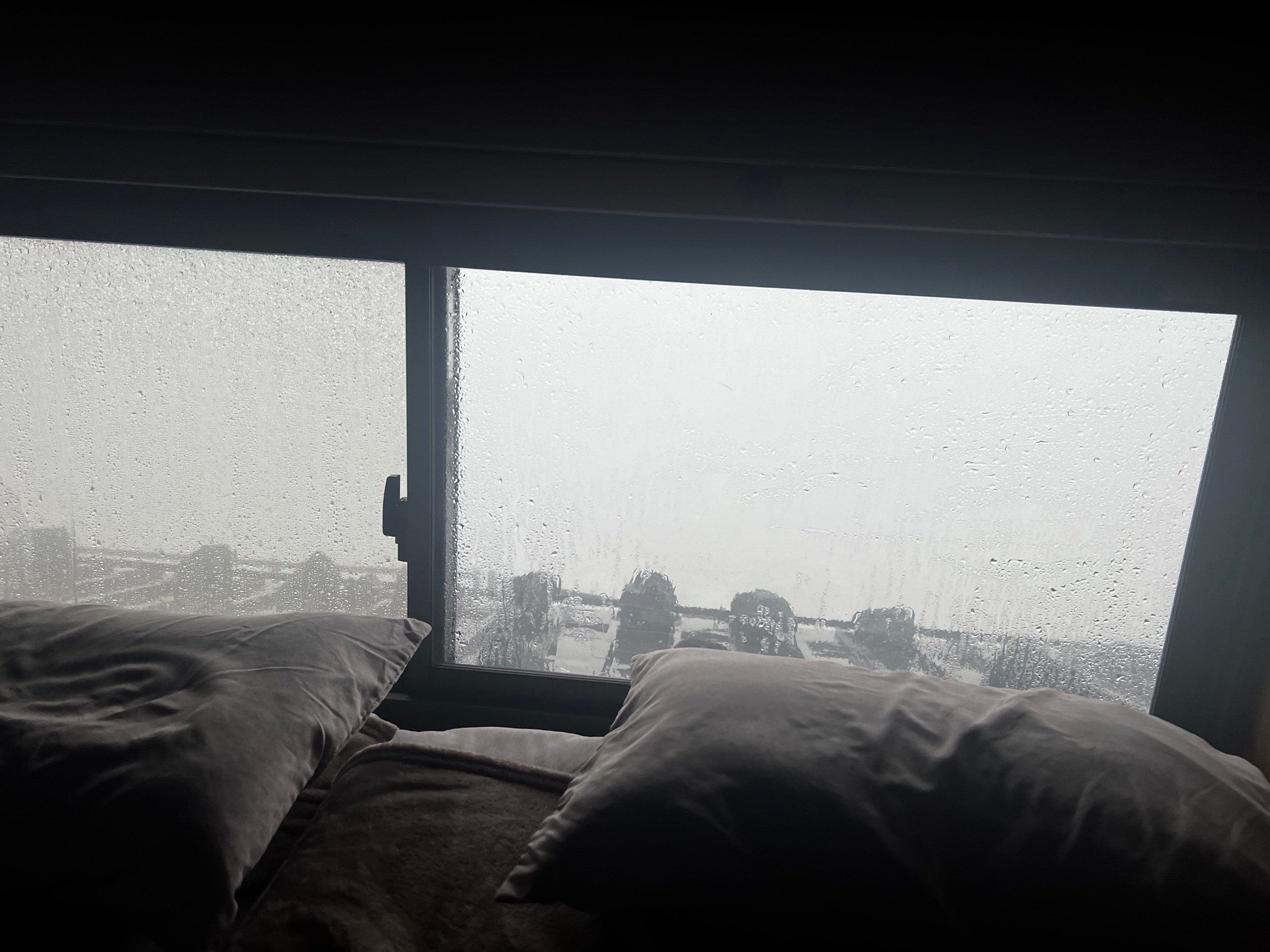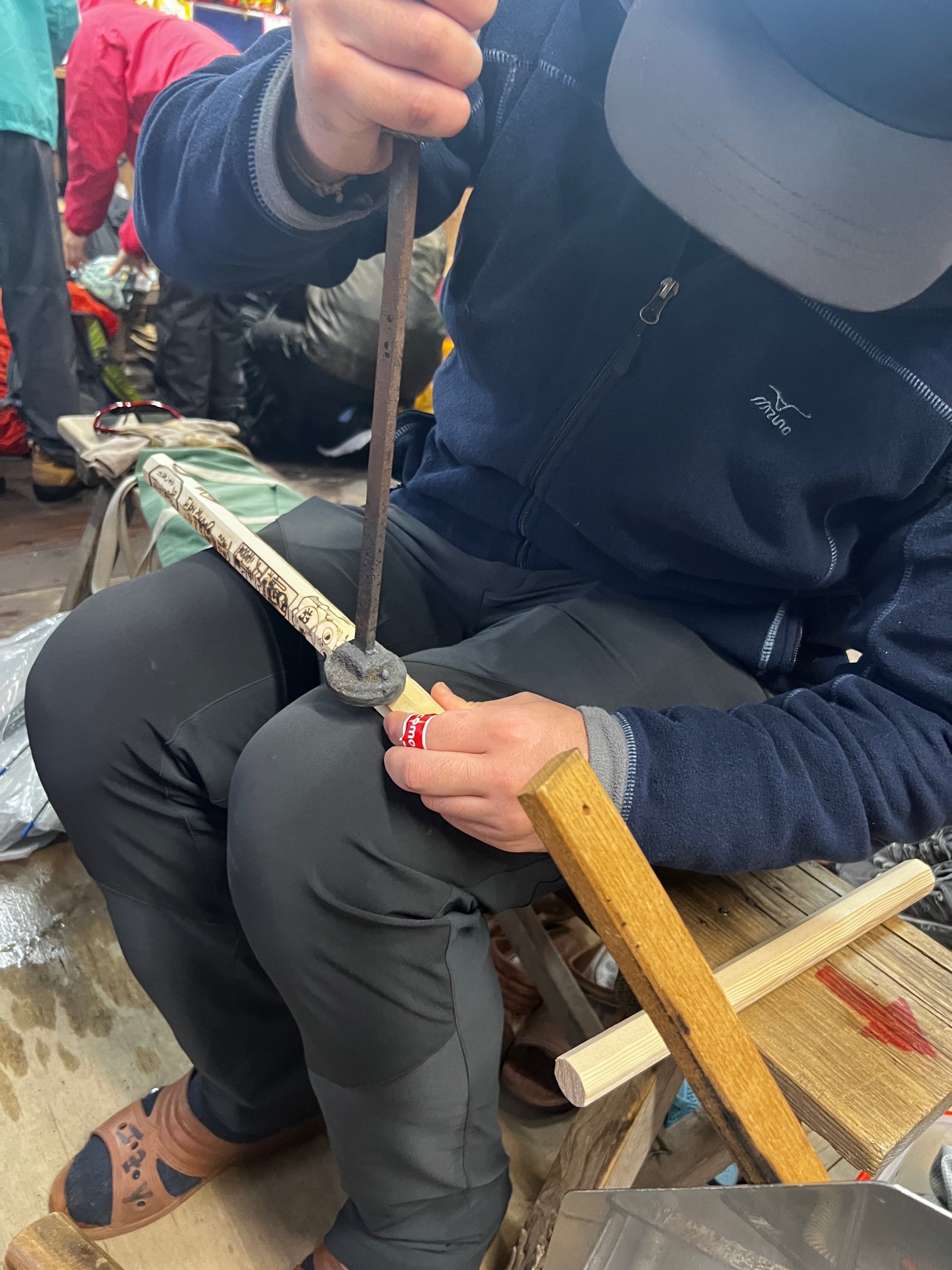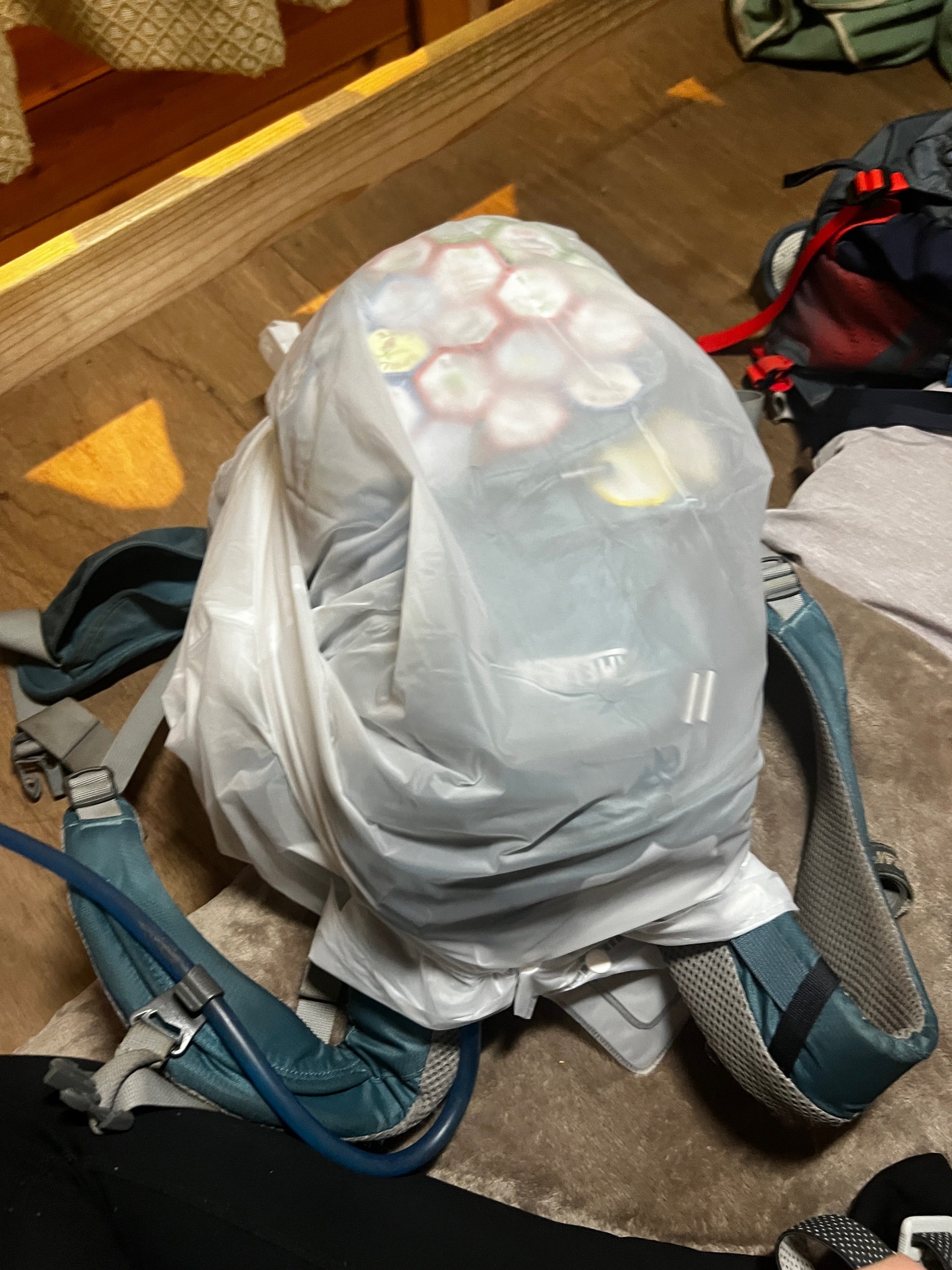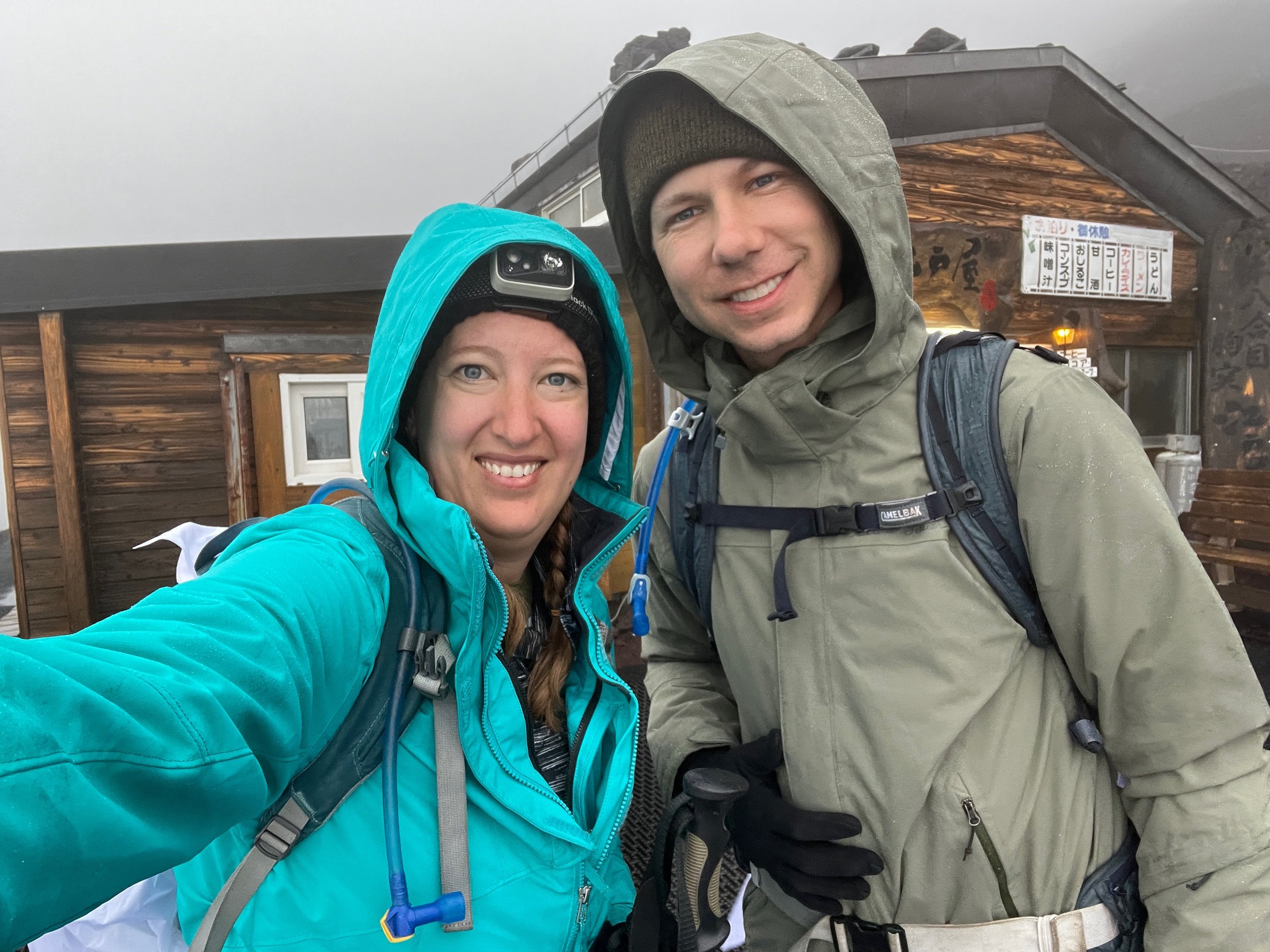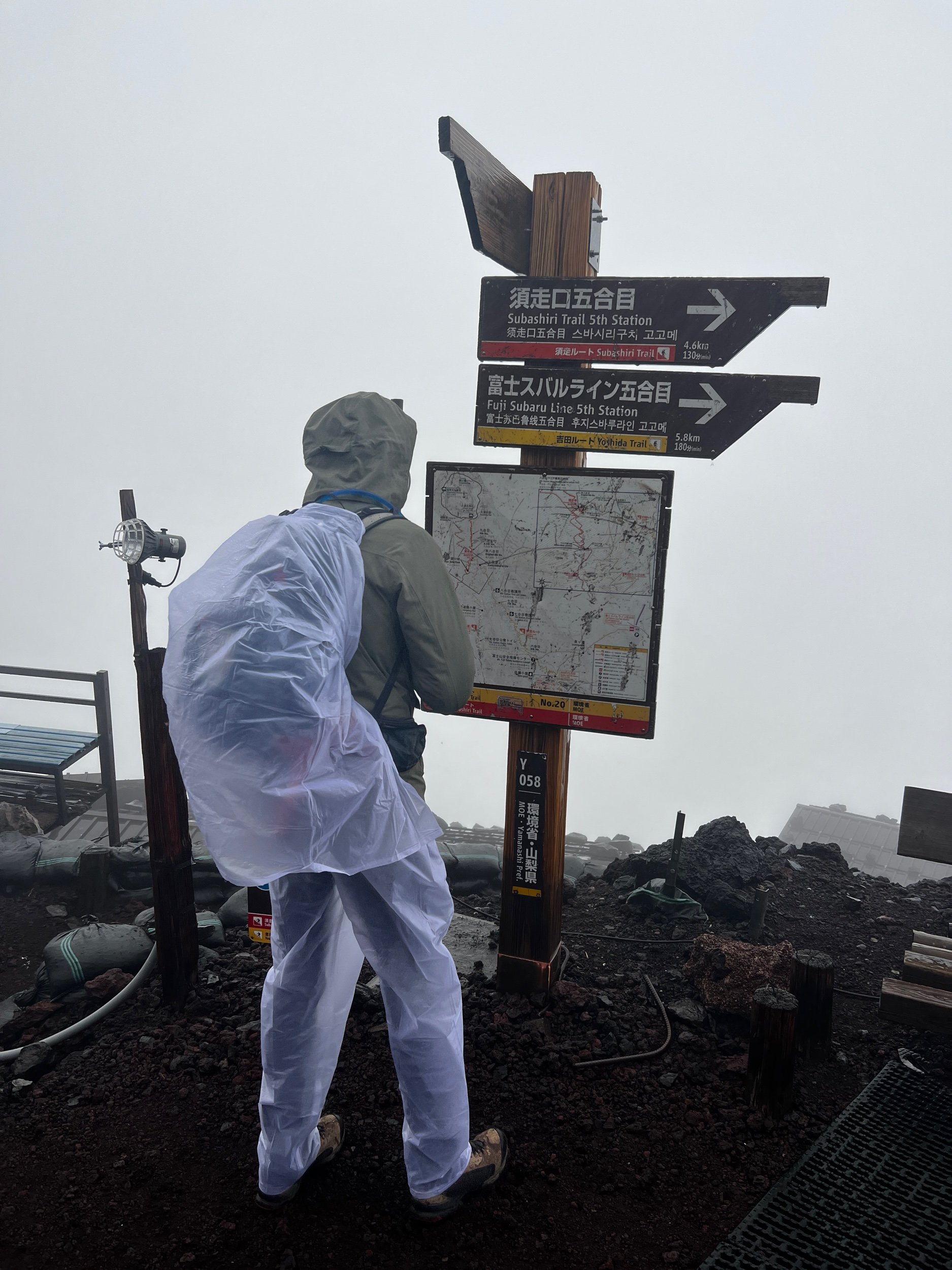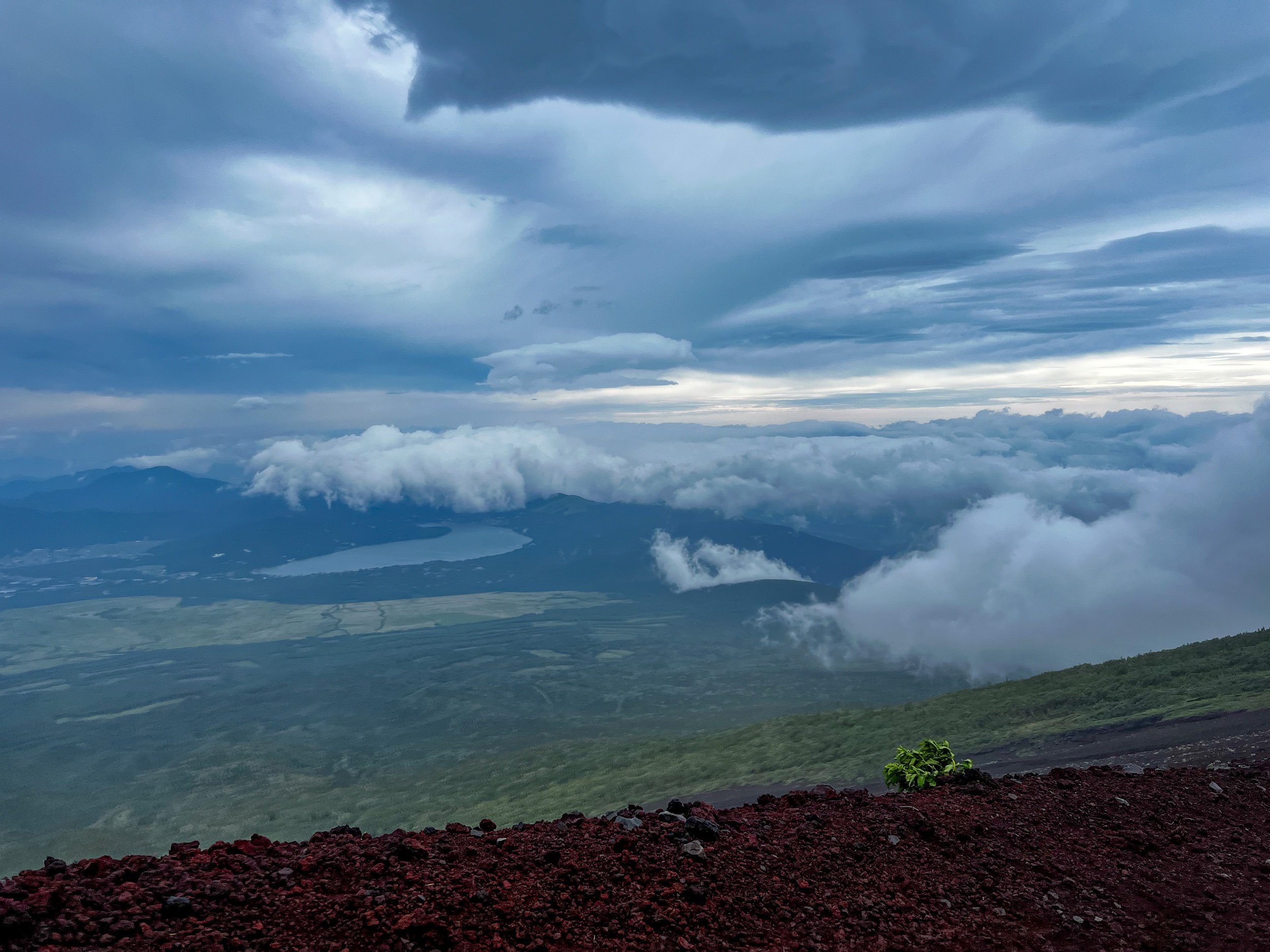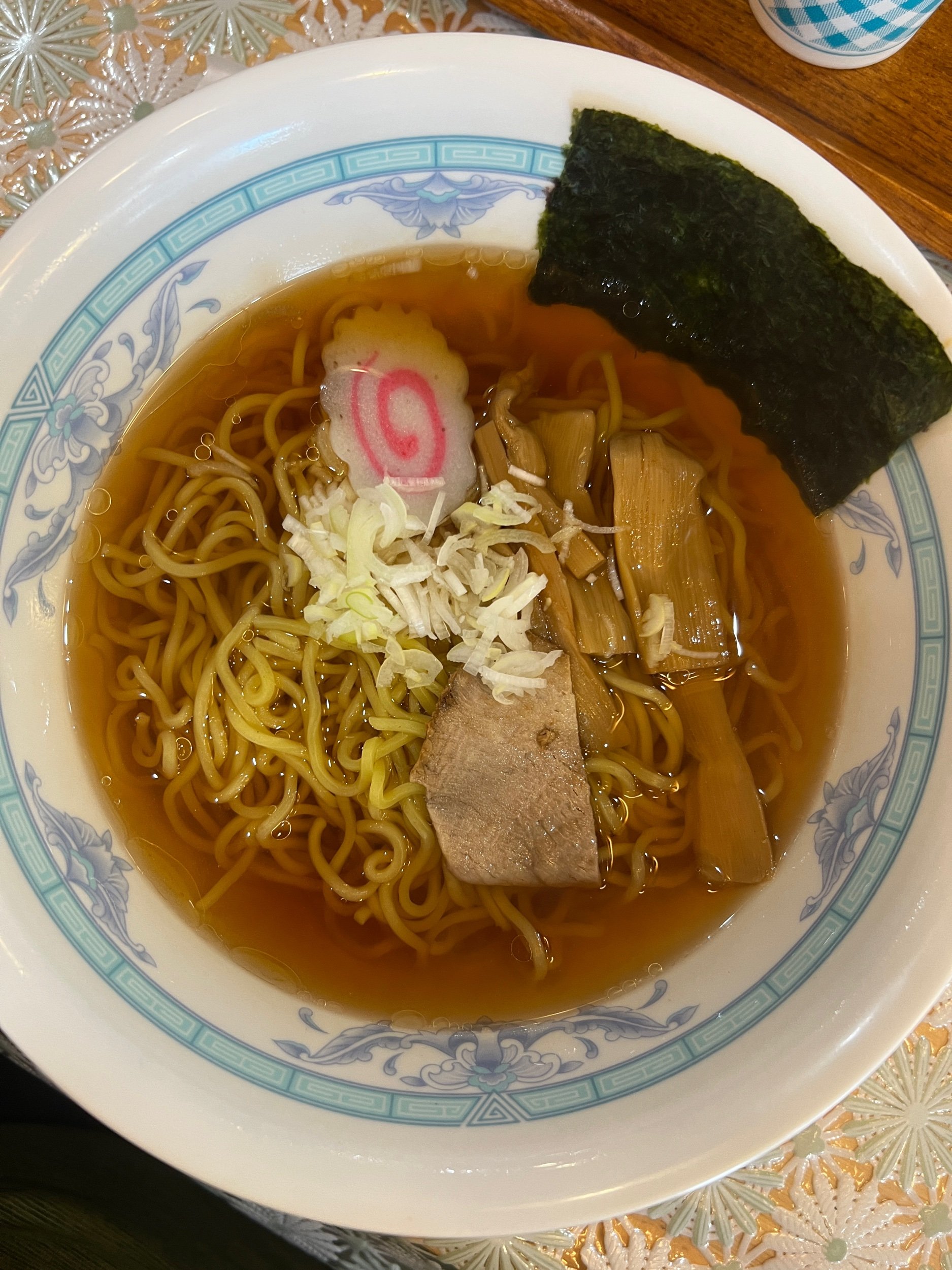A wise man climbs Fujisan once, only a fool climbs it twice.
This I now know to be true.
There are a million blog posts out there about this iconic mountain (volcano) but each experience is so different, and there are some things I wish I’d known. So here is mine.
The climb
We did our climb on Friday, July 7—our third full day in Japan. After sending our bags onward from our hotel in Tokyo, we took the express bus from Shinjuku in the morning and made it to the 5th station around 11:30. I left my ipad in a coin locker (¥600, coins only) because there were some available and was glad to not have to worry about it, but I was also glad I hadn’t relied on that service being available.
We ate some great ramen and rice at the restaurant there, and bought our sticks for stamping. I also bought some dried apricots for snacks, mostly because we realized we needed more coins for bathrooms on the way up.
Then it was time to head up! We snapped a photo in the middle area where everyone was getting their gear ready—or coming down for a well-deserved sit after a descent, their climbing sticks covered in branded designs. There were some clouds looking up at the top but the weather was otherwise great. We paid our ¥1000 each for mountain maintenance (chump change when you consider flight costs over here and the expense of maintaining a mountain full of tourists). There was an atmosphere of adventure and we started around 12:30.
The first bit was flat and in the trees. Really we were just getting to the 6th station first aid where the trail actually starts.
And then… UP. The trees don’t last long. The switchbacks up to the 7th station were crowded but I didn’t find them unbearable. We got stuck in or behind the occasional group, but found ways to pass when necessary or just went with the flow and let them maintain a healthier pace. They’ve also done a good job with the retaining walls between them, so the risk of falling rock is nonexistent. There were a few bulldozers working on the descending trail along the way. The trail doesn’t feel “wild” but it’s tough and not for the faint of heart. We were walking on loose gravel for most of the way up, and the whole way back. Not slippery like shale, and it’s light porous lava rock. It didn’t feel as “hard” on my feet as the Rocky Mountains does… but my calves and kees would tell a different story. At one point Ryan commented about the rock being the color and texture of crushed oreos.
As always, I’m atounded by plants above the treeline. On the lower elevations there are bright green ferns and a few flowers popping up from the red and black volcanic rock. It struck me as so different from the blue-grey that Fuji is depicted on in so many art works—but then, mountain experiences usually ARE vastly different when seen and felt up close.
We arrived at the first 7th station hut around 13:30 and paid for our stamp. In each hut there is a Japanese man who burns a hot branded design onto your climbing stick, commemorating your achievement in making it that far. It’s fun to watch. There are several huts between stations, each with different designs. You can also buy water, snacks, and souvenirs here, and use the toilet. It sounds insane for all of this to be on a mountain, but make no mistake: these aren’t fancy huts. And you are not allowed in most of them unless it’s an emergency or unless you have a reservation.
Somewhere after the first couple of huts is when the scrambling started. There were a decent amount of rocks to navigate over. They weren’t loose here so they were harder on the muscles than the nerves.
We counted the huts as we stopped at them, referencing a map. Our reservations were at the second-to-last hut.
The views were incredible. We could see Fujikawaguchiko and a few of the lakes at the base of the mountain. Looking up, or sometimes to the side, we could see clouds rolling quickly and gracefully down the steep red hillside.
We heard a little thunder once but remained lucky. It was comforting to know there were huts in case of an emergency and a lot of support should something really bad happen.
The people were all kind and the crowds thinned out the further we ascended. One woman even offered to take a photo of us at a hut with a shrine entrance. One man asked us if we intended on summiting that night, saying he was part of a guided tour and wished he didn’t have to stay with them. Another woman asked about my patches from Rocky Mountain National Park and took a photo.
There’s a language barrier here with some, but nobody is offended by it. There is so much kindness.
The hut part 1
We were so glad we reserved a hut at the 8th station, commenting on how tough it would be to climb all that extra in the morning.
We stayed at the Tomoekan Original 8th station hut, where we had a private room reserved. Essentially just a bunkbed with curtains. We arrived there around 16:30—much faster than we anticipated—and showed our email reservation to check in. There was surprisingly cellular service all the way up the mountain.
The men who worked there spoke very little english, but again, not much of an issue for any of us. As we were taking our shoes off at the entrance (it felt soooo good) they gave us a number for dinner and asked if we planned on summiting that evening. We had been half-joking about it the whole way up since we made such good time—and we wanted to hike around the rim while the weather was good. Ryan was seriously considering it, but we told them we weren’t sure. “Not sure” is a hard translation to convey but we made it happen.
They instructed us to put our shoes in a bag, showed us where the slippers were for bathroom use (but not inside the hut due to the tatami mats), and told us the bathrooms were outside and ¥100 for us (a 50% discount for being guests). Then they showed us to our “room.” On the way up the steps I noticed a bunch of buckets that said “for vomit, not trash.” We had a top bunk just behind the store area, and they instructed us to hang our backpacks on the hooks. There was an outlet, and a couple of windows at the head of the bed.
The bedding was better and warmer than I expected, with puffy bedding and plenty of room, even for my 6’ 6” husband. He commented that it was even more room than Tokyo.
I hadn’t stopped for a snack break, thinking this was the end of our journey for the day and we’d wake up at 02:00 for a sunrise summit the next morning.
We were laying in our quiet bed with extremely sore legs. So I wasn’t sure what to say when we discussed going on today. There were so many unknowns… the Japanese culture is full of process and rules that help everyone, so we weren’t sure what we were allowed to do from a hut/dinner perspective since it was another 1.5 hours to the top. On the other hand, the weather was good now and didn’t look promising the next morning. Sunrise on Fuji in the Land of the Rising Sun is a thing—but the sunset was likely to be great too.
Ryan finally braved the cultural differences to use Google Translate and ask if we were allowed to go up, and what time we had to be back for dinner. After a somewhat confusing exchange, they said we were welcome to come and go as we pleased anytime—but that we had to give our dinner number back now and would receive a new one upon return. It was Ryan who said “let’s go.”
The last hour and a half to the top was exactly that—an hour and a half. No beating the estimated time on that one. And it was steep. My knees were complaining and at one point the altitude sickness started to get me. I felt overwhelmed and cried a little since I’d pushed it so far. We were wondering if we’d regret the evening summit. Ryan had said he might go again for sunrise, even if we did this, but my body was screaming no at me.
600m to the top. At 400m left, there was an Original 9th station ruined hut, now just the wooden frame half buried in the volcano. We could see the summit the whole way and I started to count my steps. There were only a few people, but at one point a Japanese man descending told me “only 30 more minutes.”
And then we could see the summit shrine, completely worn wood guarded by two stone statues.
I cried with emotion that we were almost there. It sounds silly, but it had taken everything I had to get up there. It was 18:00.
THE SUMMIT
As we summited, the small huts and temple were just closing their windows shut. No summit stamp for us, which was hugely disappointing. I had had hopes of sending postcards from the top and enjoying the “amenities” that this mountain had at the summit. I later found out there was a Goshuin (a calligrapher for each temple) at the top, and that those pieces were rare among goshuin collectors (for obvious reasons), so I’m sad we missed it. But my book will just have to live without them.
There were perhaps 5 others at the summit. It was quiet as the light began to wane. We took some photos for each other, and Ryan and I walked around a little. It seemed that they were starting to rope off the rim hike. But we swallowed the disappointment and walked over where we could, putting on our hats and heavy jackets to combat the cold.
It was so still and quiet. The view was amazing—soft light from the cloudy sunset surrounded everything, and we could see several lakes below us.
Walking toward and partway around the crater rim, we could look into the volcano, the red dirt, black rock, and snow cascading down into the cone. We walked partway around and found a very small shrine and a small Fuji podium and statue. All regrets and disappointment seeped away as we took in the silence.
We were on the top of Mount Fuji, the highest point in Japan, and it was incredible.
The hut part II
18:30. Going back down was exhausting and we once again wondered if we were going to regret going up early as I decided definitely NOT to go back for sunrise (Ryan, in his beautiful insistence, still wanted to go again for the summit patch). My knees were not happy and the hunger was setting in. We counted the metered signs on the way down (“we’re 1/3 of the way there”) and met a few others who were going for the summit that night too. A family (maybe from Australia, based on their accent?) stopped on their way up to tell us the mountain hut workers had mentioned that the summit might be closed in the morning due to weather.
We finally got back to our hut and were beat. After a bathroom break we went back inside and got a new number for dinner. My whole body hurt as we climbed into our bunk to rest and reorganize for the night. I was coughing and having trouble catching my breath. It’s when I finally told Ryan there was zero chance of me going up again and he agreed, but said he still might on his own. I didn’t hate the idea of sleep and coffee in the morning, thinking if the weather was good I’d just relax and enjoy the view outside as everyone else went up. They called a few numbers in english that weren’t ours, and then some in Japanese… eventually someone came over to us to tell us it was our turn.
I had been worried about dinner. We sat down on the cushions on the tatami mats and ate. It was rice, a beef patty, some curry sauce, and some hot green tea. They also gave us our packed breakfasts for tomorrow so we could eat whenever.
I don’t know if dinner would have been good under normal circumstances, but in that moment it was incredible (except for the curry sauce, which I chose to abstain from due to my unsure stomach). The rice was filling and I felt better.
During dinner, the workers read in both Japanese and English from a script about the process in the morning (sunrise time, letting us know we were free to leave some stuff here, and that checkout was by 8:00am.
We had a private room but I wanted to ensure sleep, especially since I wasn’t getting up in the morning. Some of the other mountain huts just have people sleeping on the tatami, shoulder-to-shoulder… I’d read how loud they can be in general. So I bought a set of earplugs for ¥100. While we sat and drank our tea, another couple we had talked with at the 7th station hut arrived. They asked if we had summited already (yes) and told us they heard we could get summit stamps right there if we wanted! In that moment we were too tired to ask.
I slept well and warmly, only waking up a few times to the sound of rain and howling wind.
The hut seemed very protected and I felt warm and safe. I had hopes the storm would pass by the morning and kept sleeping.
I woke up for good at 5:17. Our clear view had been replaced by a pure white shroud of fog and it was spitting rain outside. The wind was still howling. I looked at Ryan, who was still considering going back up like a crazy person… but when he returned from his trip to the bathroom, he said it was out of the question. We looked outside and checked the weather forecast on our phones… it didn’t look promising and we knew we’d have to make it down in that weather.
After a few minutes we (very sorely and gingerly) made our way downstairs to sit on the tatami for breakfast. We bought a couple of hot coffees and ate a pig-in-a blanket, a croissant, and a roll with some butter and jam. The carbs were welcome.
As we ate we watched people come in looking miserable from outside. Last night the door was open and it was calm. This morning was a rush of people coming in a burst of wind as they scrambled to close the door, and sit down to dry off and take their shoes off. Others were putting on their rain gear and layering up. There was no escaping the weather, so we bought rain suits at the hut for ¥1500 each, putting the pants on and using the shirts to cover our backpacks as best we could.
I used Google translate to ask if we could get a summit stamp there. The men said yes, but looking unsure, asked if we’d actually made it up. I told them we had, and we got the coveted stamp there in the hut. As we were heading out, an older man who spoke almost no english said something about the summit to us. We said we weren’t going that way, but he kept shaking his head and crossing his arms in front of him to indicate “no.” The summit had closed.
The descent
06:17. And into the white we went.
For the first bit we followed the same trail down, because previous maps and info had said the descending trail had construction. But at some point they turned us to the right and we went down the wider bulldozer path instead of the more scrambling route. This meant no huts on the way down.
Five days later the descent memory is already a blur. I mostly remember the white against the red rock. It was misty in the cloud and our glove liners were soon drenched. I was grateful to have my ski jacket with a hood and waterproof shoes. Every once in awhile the wind would gust and we’d have to brace ourselves from falling. We could literally ring out our gloves, though they weren’t cold, acting as some kind of wet suit for our hands.
We did see an emergency vehicle pass us with a passenger in the truck bed wearing a silver blanket. Later on, at the 6th station first aid, we saw that vehicle and several others in an emergency area to help people.
All that said, it wasn’t as bad as I had thought. It was steep, with loose (but not slippery) gravel, and my legs were unhappy with me, but the switchbacks provided some relief. After about 1.5 hours of the white abyss, we made it to some thinner clouds and could see the sky and view a little. The green plants were back on the ground. At the 7th station I took off my middle insulating layer and we took a bathroom break and moved forward.
Eventually we made it into the trees. Some other Americans stopped and asked us what the conditions were “how was the camping?” (Which you cannot) and said they lived there so they weren’t sure how far up they would go.
Toward the 5th station base it became more crowded. One man we passed looked right at me, then looked at his friend and said “it’s amazing how many miserable faces you see coming down!”
The truth is I wasn’t miserable. Sore, tired, wet, yes. Ready for hot ramen, absolutely. Happy? Maybe not in that moment. But I wasn’t miserable, just focused on the goal ahead.
A descending man who passed us asked where my backpack patches were from and said he’d been to Denver. We found out he worked in emergency services and he said he’d treated a woman with Hypothermia that morning. Everything she had had gotten wet and cold. When we said that we appreciated knowing services were there and how it was different from home, he said “Fujisan is different. You guys clearly know what you are doing and are prepared, but we get a lot of tourists and westerners who don’t. They come in shorts and without water.” (Being from Colorado, we understand this problem).
And then, seemingly out of nowhere, we were there. The 5th station. With the worst wind we’d felt yet. And hot ramen awaiting us at 9:00am. And it was so good.
Later that day we went to Chureito Pagoda, with the iconic Fuji view in the background. And we could see her from the onsen in our Ryokan. Always capped in cloud. The only time we ever saw the top clearly was when we were standing on it.
And for the rest of our trip we’d tell others. The woman at the tea house, who was concerned when my sore legs made it hard for me to get uo from kneeling. Her eyes got huge when we told her why. I could barely walk those first couple of days after, my calves protesting and my knees threatening to buckle as we climbed the concrete steps to Kiyomizudera.
And every time we see a photo of Fujisan, we’ll see it differently.
I’ll see the old Japanese man making the “no” sign with his hands. I’ll remember the tatami mats and green tea in tbe hut. I’ll remember the shrine at the summit and the quiet of the crater. I’ll know she is shy and shows her face sparingly, preferring to be covered in a misty windy white abyss. I’ll think about the rich loose volcanic gravel. We’ll forever remember the atmosphere of adventure and the comradarie. It feels…epic. Like the adventure of a lifetime.
Once in a lifetime.

